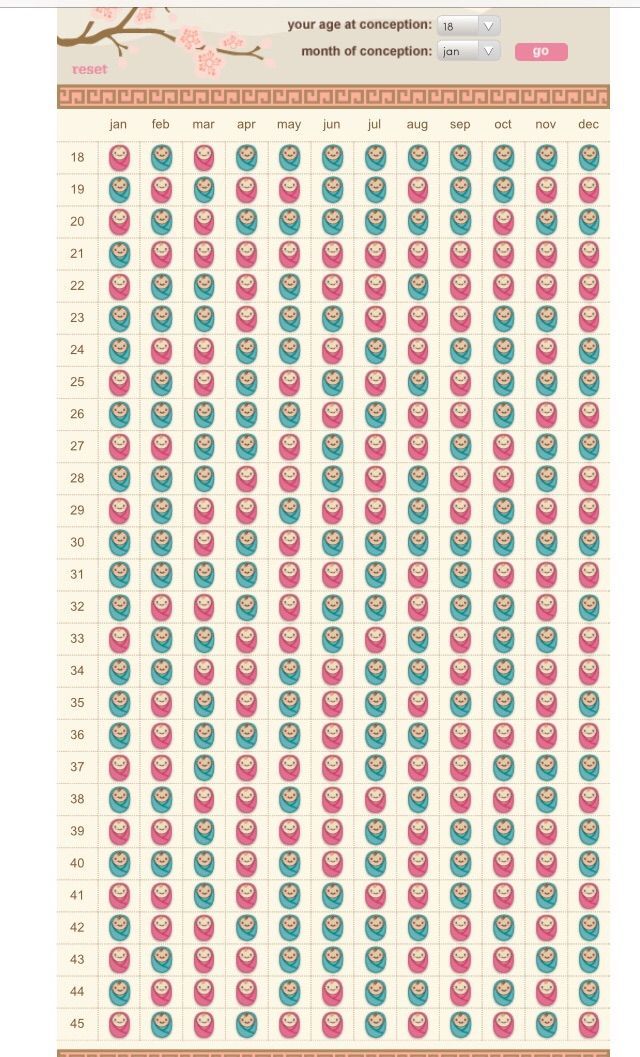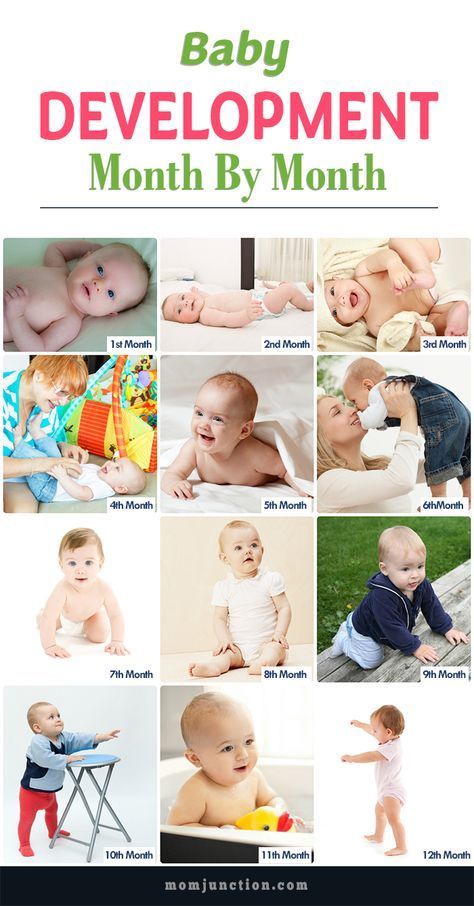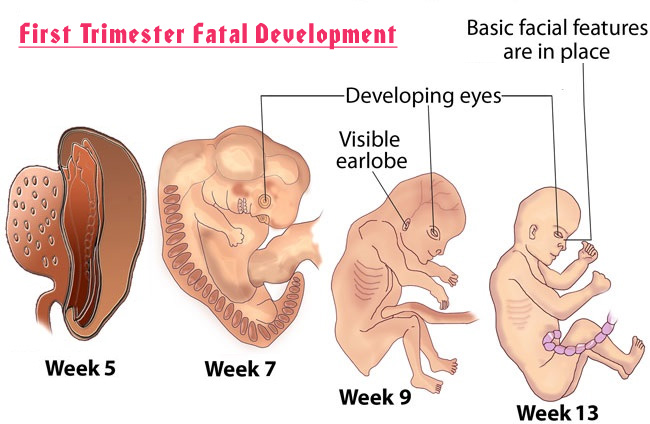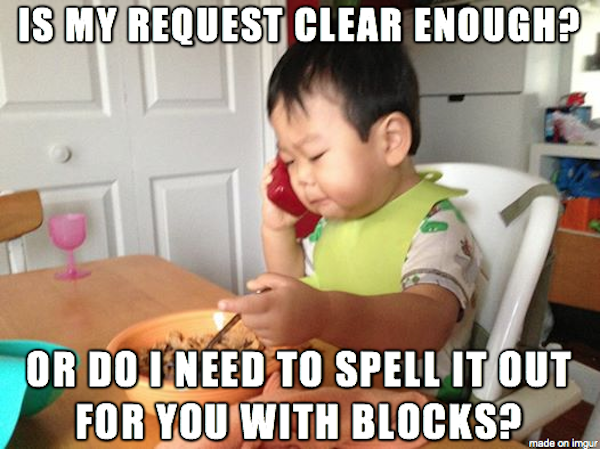Speech development in babies timeline
Baby talking timeline: Baby speech development timeline
- Community
- Getting Pregnant
- Pregnancy
- Baby names
- Baby
- Toddler
- Child
- Health
- Family
- Courses
- Registry Builder
- Baby Products
Advertisement
From that first coo to the full play-by-play of their day at school, children's language skills usually develop in an orderly fashion. Here's an idea of what to expect when – but it's perfectly normal for a child to hit these milestones a little early or a little late.
Photo credit: iStock.com / IPGGutenbergUKLtd
Baby
| Birth to 3 months | Makes quiet cooing sounds when pleased. These are typically a single vowel, like ahhhh. |
| 2 to 3 months | Cries differently in different situations. As you get to know your baby, you may be able to distinguish a hunger cry from a sleepy cry, for example. |
| 3 to 4 months | Vocalizes mostly vowels, but cooing becomes a little more sophisticated, with more varied sounds. |
| 5 to 6 months | Begins to babble, making sounds like "muh-muh" or "bah-bah." Practices intonation by making their voice rise and fall. Red flag: If your child isn't making vocal sounds by the time they're 6 months old, talk with your doctor. |
| 7 to 12 months | Babbles with greater diversity, making new sound combinations and intonations. Tries to imitate your speech with phrases like "bah-BAH-bah" or "dee-dee-dah." Has pretend conversations with you, taking turns "talking." Red flag: If your child isn't making both consonant and vowel sounds by age 7 months, talk with your doctor. |
Toddler
| 12 months | Says their first word. |
| 14 months | Uses inflection (for example, raises their voice at the end of a question, like, "more?") and makes hand gestures to complement their speech. Red flag: If your child isn't saying any words by age 15 months, bring it up with your doctor. |
| 16 months | Talks to someone much of the time as opposed to just babbling to no one in particular. Calls you to get your attention ("Mommy!"), nods and shakes head for yes and no. Makes many common consonant sounds, like t, d, n, w, and h. |
| 18 months | Has a vocabulary of several words, including names ("Mama"), verbs ("eat"), and adjectives ("cold"). |
| 18 to 24 months | Uses common phrases ("want doll") to make requests. Starts putting two-word phrases together for more novel purposes ("Daddy go," "milk mess"). |
Preschooler
| 24 months | Uses short, two- or three-word sentences and personal pronouns ("I fall down!" "Me go school?"). |
| 2 to 3 years | Can carry on a simple conversation about something in the immediate environment. Asks simple questions frequently. Expands phrases from three- to six-word sentences and develops a vocabulary of many words, including lots of verbs. Uses past tense by adding a "d" sound to verbs ("runned") and plurals by adding an "s" sound to nouns ("mans"). Uses pronouns (I, she, we) correctly. Red flag: If your 2- or 3-year-old always echoes your questions instead of answering them, tell the doctor. This could be an early sign of a social or language delay. (If they occasionally repeat your question as part of their response, it's nothing to worry about.) |
| 3 to 4 years | Favorite words often include "why," "what," and "who. Red flag: Your child may sound as though they're stuttering if they get tripped up on their words in their excitement to communicate. This is perfectly normal. If it continues for more than six months, though, or if they tense their jaw or grimace while trying to get the words out, ask your child's doctor for a referral to a speech pathologist. |
Big Kid
| 4 to 5 years | Communicates easily and can retell a simple story with a beginning, middle, and end while looking at pictures. Can use four to five sentences to describe a picture, with most of the grammar elements in place. Uses more than one action word in a sentence. Pronounces most sounds correctly but may still have trouble with th, r, s, l, v, ch, sh, and z. Uses lots of descriptive words, including time-related words like "yesterday. |
| 6 to 7 years | Can describe how two items are the same or different, retell a story or event without the help of pictures, and recount past conversations and events. Uses some irregular plural nouns ("men," "teeth"). |
| 8 years | Has mastered all speech sounds as well as the rate, pitch, and volume of speech. Uses complex and compound sentences correctly and is capable of carrying on a conversation with an adult. |
Learn more:
Baby milestone: Talking
How your baby understands you
Signing: How to communicate before your child can talk
Darienne Hosley Stewart
Darienne Hosley Stewart is a content strategist, writer, and editor. She lives in the San Francisco Bay Area with her spouse, two teenagers, a goofy dog, and even goofier chickens. She enjoys movies, gardening, reading, and quiet outdoor spaces.
Learning to talk - stages, supporting your child
Learning to talk - stages, supporting your child | Pregnancy Birth and Baby beginning of content6-minute read
Listen
Learning to talk is an important part of a child’s development, although many of us take for granted the way a young child interacts with others by using their voice.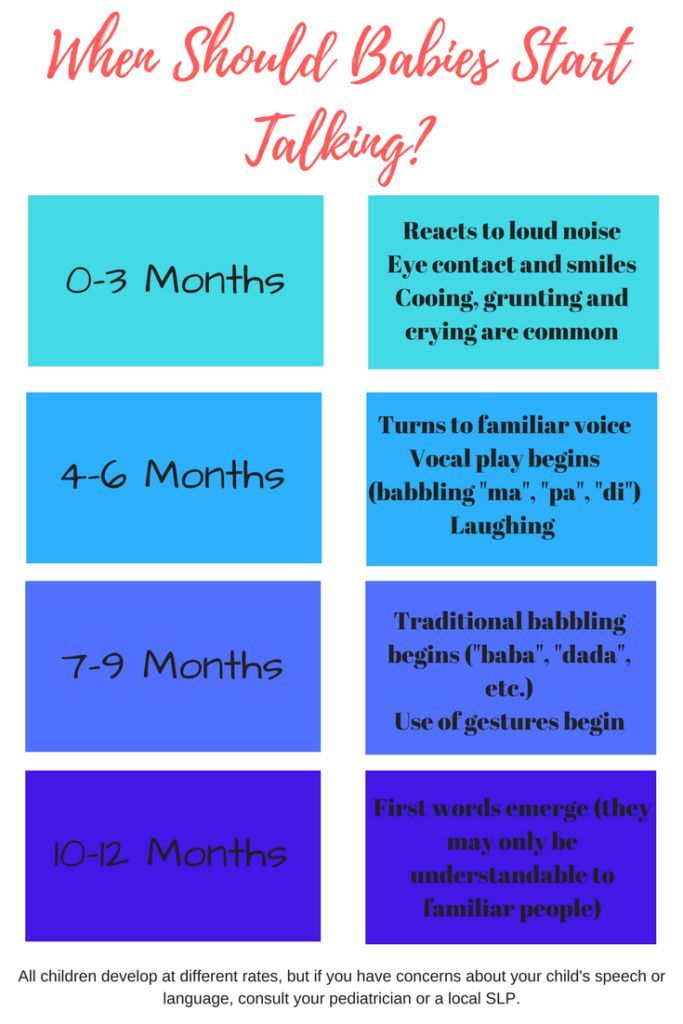 Learning how to communicate clearly using words and language takes thousands of hours of practice and repetition.
Learning how to communicate clearly using words and language takes thousands of hours of practice and repetition.
As a parent, you might find it useful to understand how your baby develops their own, unique skills in learning to talk.
How do babies communicate?
Even while they’re still in the womb, babies can hear muffled noises and learn to recognize their mother’s voice. Often, babies will respond to familiar voices by becoming more active.
Babies develop in a head-to-toe direction. The first vital stages of development are centered on ways babies can connect emotionally with those who are caring for them. Establishing eye contact, learning how to smile and coo, and seek to engagement from adults close to them, helps to ensure their survival.
Your baby’s first language
Crying is the main way young babies communicate their needs. They also communicate with others by using sounds and gestures. What starts in the early months as smiling, cooing and babbling, by 12 months becomes clearer attempts to form first words.
From the age of 2 months
Babies start to coo and make sounds that form the building blocks of speech. Babbling is a phase of speech development, and you’ll hear the sounds 'ma ma', 'da da' and 'bubba'. Around this age they also learn to clap their hands and wave bye-bye.
In the first year, babies gradually learn to express themselves in many ways. They copy sounds they hear, blow ‘raspberries’, laugh, imitate a cough and learn to squeal.
After their first birthday
Toddlers can now form clearer words, like 'dog' and 'ball', and then progress until by around 2 years they can say up to 50 words and understand many more.
Between the ages of 3 and 4 years
As they begin to learn language, a lot of what they achieve will be motivated by curiosity. Toddlers learn to ask ‘why’ and repeat words they hear. Their speech starts to become clearer and they chat to themselves. Toddlers will also join in rhymes and songs, and recognise familiar patterns in books.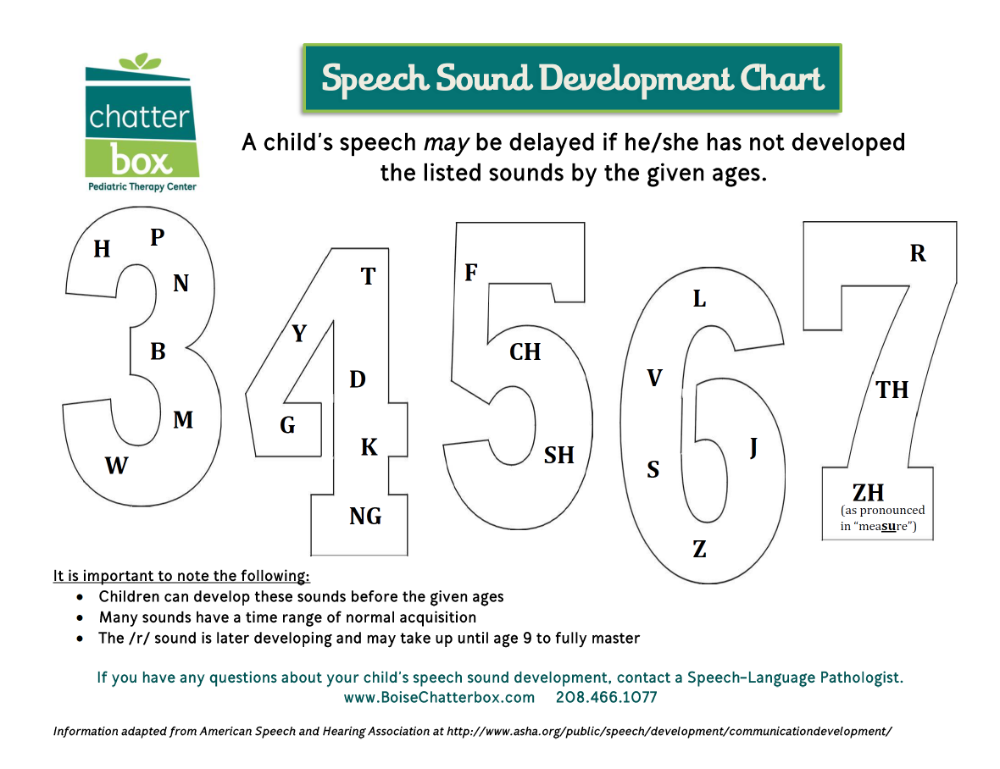
Between 4 and 5 years
By this time, children have become much clearer in their speech. Fantasy plays a large part in their play and they make up complex stories. Some sounds — such as 'th', 'r' and 'v' — can be more difficult to pronounce. Most children in this age group can have a conversation with an adult and be clear.
Language and speech development
Learn how you can help your child to talk and develop their language and speech skills.
How do I encourage my baby to learn to talk?
Get used to talking to your baby before they are born. Early emotional connection starts even when babies are in the womb.
After your baby’s birth, speak gently to them and watch and listen for their responses:
- Name what you are doing and talk about it. Have conversations and encourage them to chat back to you.
- Be interested when they talk back. Learning is hard work — it’s important you praise their attempts.
- Get down to their eye level so they can see your mouth moving as you speak.
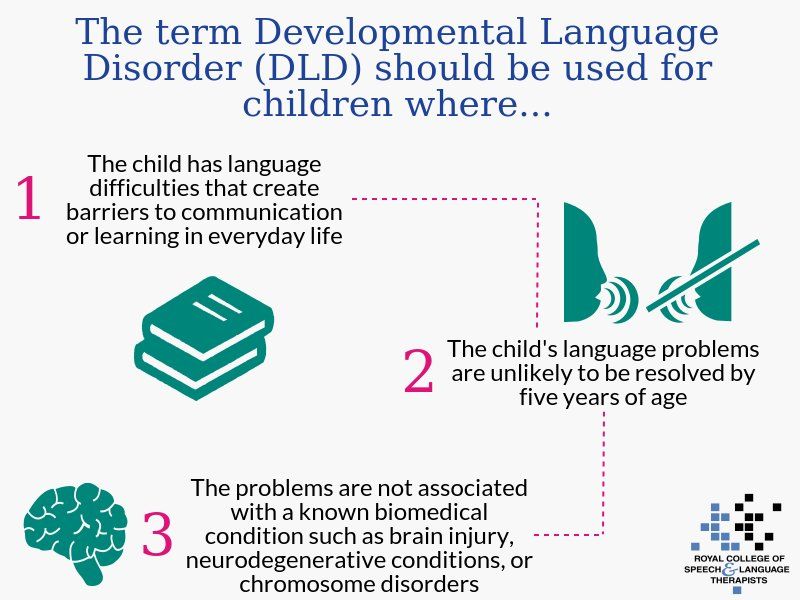 Forming new words is helped by copying what you do.
Forming new words is helped by copying what you do. - Aim to be ‘in tune’ with your baby, and give them time to react to your voice.
- Talk with your baby every day, but try not to be too particular about when and how you do this. What’s important is to be authentic and sensitive — your baby will not be critical.
- Use your baby’s name when you talk to them.
- Read to your baby every day. Don’t be surprised if they want the same, familiar book each time.
When should I be concerned?
Check your baby’s Child Health Record book to make sure they passed their hearing test at birth. Sometimes a 'refer' test is recommended, in which case the hearing test will need to be repeated in a few weeks.
Hearing loss for any reason can cause delays in learning to talk.
Have your baby checked by a health professional if:
- you have any concerns about their development
- they don’t react to loud noises, even from birth
- they have a significant loss of skills or, they don’t seem equally strong on both sides of their body
- they don’t respond to sound or sights
- they are stuttering — most children begin stuttering between 2 and 5 years and although most will stop without treatment, some do not
- they are not interacting with you or other people.

- they have limited eye contact
- they seem floppy, or stiff and tense
‘Red flag’ stages of speech development
Every baby is unique and develops in their own time. Many factors play a role in how children learn to talk. Early identification of speech delay or problems can make a big difference in getting the right level of support.
'Red flags' help to pick up problems in the early stages of a baby's development. Check their progress regularly.
| By 6 months | Your baby should be starting to babble (e.g. aahh, oohh). |
| By 9 months | They should be pointing and using their hands by waving and clapping. Babbling and using 2 sounds together (e.g. mama, dada, and bubub). |
| By 12 months | They should be making sounds that are more like talking.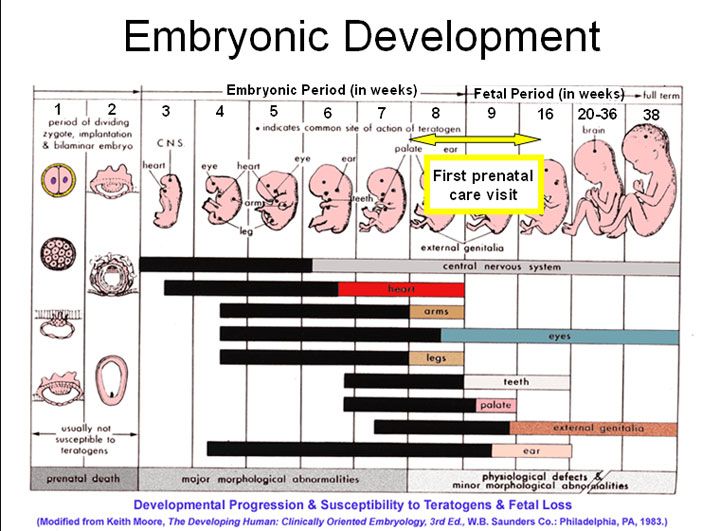 Responding to familiar words. Responding to familiar words. |
| By 18 months | They should be saying clear words and understanding requests (e.g. 'Give me the ball'). |
| By 2 years | They should be learning new words and putting words together. |
| By 3 years | Their speech should be clear enough to be understood by anyone and they are using simple sentences. |
| By 4 years | They should be using speech that can be clearly understood. Able to follow directions that have 2 parts (e.g. 'sit down with your teddy'). |
| By 5 years | They should be able to tell you what is wrong and to have a simple conversation. |
Who can I speak to for help?
Check with your child health nurse if you have any concerns about your baby’s development. Your GP will also be able to refer your child for assessment and treatment if it’s needed.
Your GP will also be able to refer your child for assessment and treatment if it’s needed.
Speak to a maternal child health nurse
Call Pregnancy, Birth and Baby to speak to a maternal child health nurse on 1800 882 436 or video call. Available 7am to midnight (AET), 7 days a week.
Sources:
Raising Children Network (Babies connecting & communicating), Raising Children Network (Babies: language development), HealthyWA (Learning to talk), ParentLink (Learning to talk), Children’s Health Queensland Hospital and Health Service (Red Flags Early Identification Guide), Sydney Children’s Hospitals Network (Stuttering)Learn more here about the development and quality assurance of healthdirect content.
Last reviewed: May 2021
Back To Top
Related pages
- Speech problems in children
- Talking to your toddler
- Talking to your child
- Talking to your baby
Need more information?
Learning to talk
Learning to talk is one of the most important steps for your child.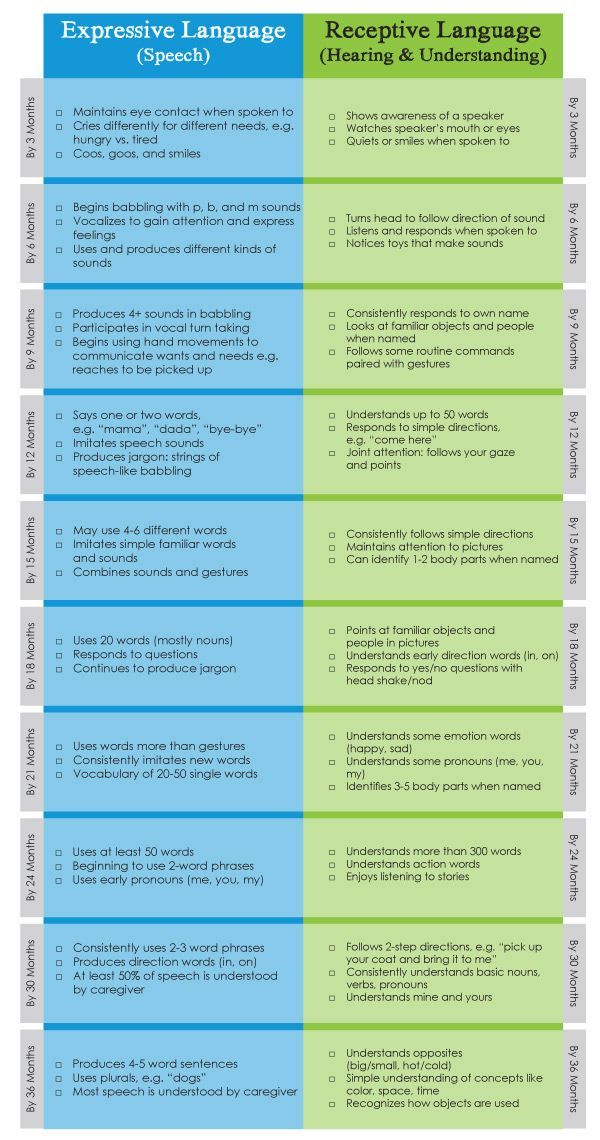 Talking helps them make sense of the world, ask for what they need and get along with other people.
Talking helps them make sense of the world, ask for what they need and get along with other people.
Read more on WA Health website
Talking to your baby
Talking to your baby, even if they can't talk back yet, is the best way to get them started to learn how to talk.
Read more on Pregnancy, Birth & Baby website
Talking to your toddler
Toddlers make a lot of noise, but it will take time and practice for it to make sense. Learn how to talk to your toddler.
Read more on Pregnancy, Birth & Baby website
Talking to your child
By the time your child is 4, they should be talking and you'll have your own style of communicating with each other.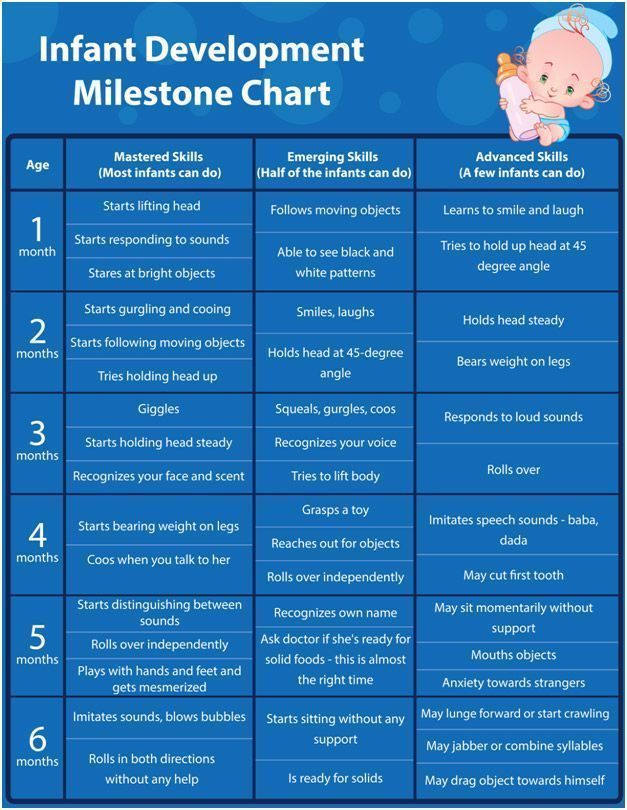 Learn how to help your child develop their language skills.
Learn how to help your child develop their language skills.
Read more on Pregnancy, Birth & Baby website
Speech problems in children
Speech problems are common in young children but some speech troubles can indicate a speech or development delay. Find out when to seek further advice.
Read more on Pregnancy, Birth & Baby website
How baby learns in the womb - Ngala
From the moment of conception your baby is developing rapidly
Read more on Ngala website
Your baby's growth and development - 10 months old
A 10-month-old will be very active. As a parent, you’ll probably be chasing them around as they crawl, and be learning more about their developing personality.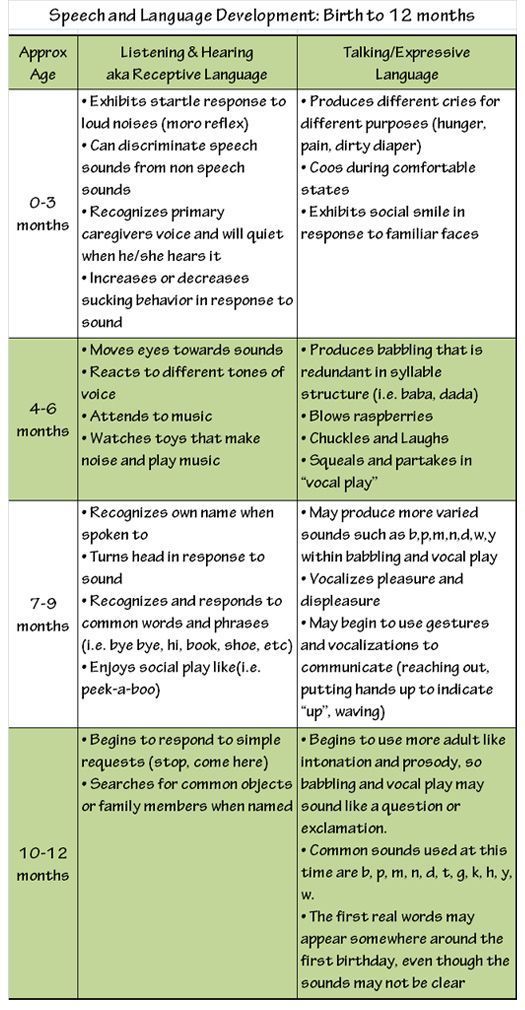
Read more on Pregnancy, Birth & Baby website
Stuttering in children
Stuttering is a speech disorder that usually starts between the ages of 2 and 5 years. Learn more stuttering and when to seek help.
Read more on Pregnancy, Birth & Baby website
Language development: children 0-8 years | Raising Children Network
Language development underpins cognitive, social and literacy development. A lot of talking responding and reading with you helps your child learn language.
Read more on raisingchildren.net.au website
Dyslexia in children - MyDr.com.au
Dyslexia is a common language-based learning disorder that makes it difficult for children to read, write and spell. It is not caused by a lack of intelligence or unwillingness to learn.
It is not caused by a lack of intelligence or unwillingness to learn.
Read more on myDr website
Disclaimer
Pregnancy, Birth and Baby is not responsible for the content and advertising on the external website you are now entering.
OKNeed further advice or guidance from our maternal child health nurses?
1800 882 436
Video call
- Contact us
- About us
- A-Z topics
- Symptom Checker
- Service Finder
- Linking to us
- Information partners
- Terms of use
- Privacy
Pregnancy, Birth and Baby is funded by the Australian Government and operated by Healthdirect Australia.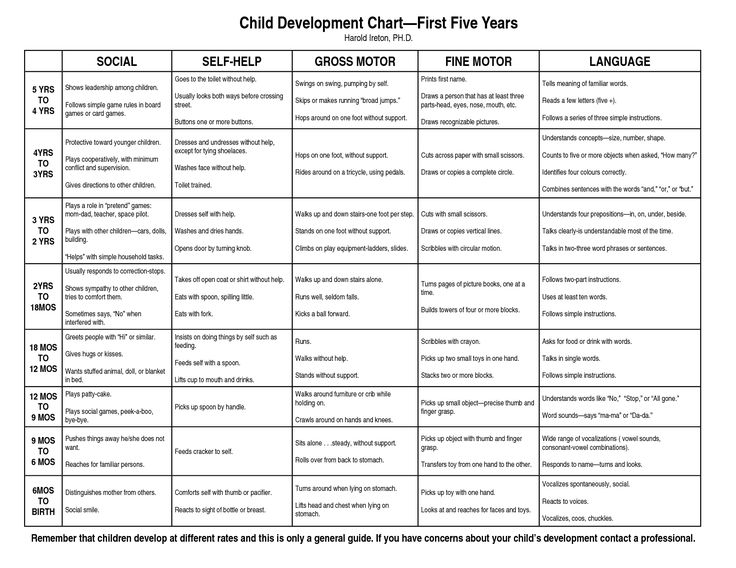
Pregnancy, Birth and Baby is provided on behalf of the Department of Health
Pregnancy, Birth and Baby’s information and advice are developed and managed within a rigorous clinical governance framework. This website is certified by the Health On The Net (HON) foundation, the standard for trustworthy health information.
This site is protected by reCAPTCHA and the Google Privacy Policy and Terms of Service apply.
This information is for your general information and use only and is not intended to be used as medical advice and should not be used to diagnose, treat, cure or prevent any medical condition, nor should it be used for therapeutic purposes.
The information is not a substitute for independent professional advice and should not be used as an alternative to professional health care. If you have a particular medical problem, please consult a healthcare professional.
Except as permitted under the Copyright Act 1968, this publication or any part of it may not be reproduced, altered, adapted, stored and/or distributed in any form or by any means without the prior written permission of Healthdirect Australia.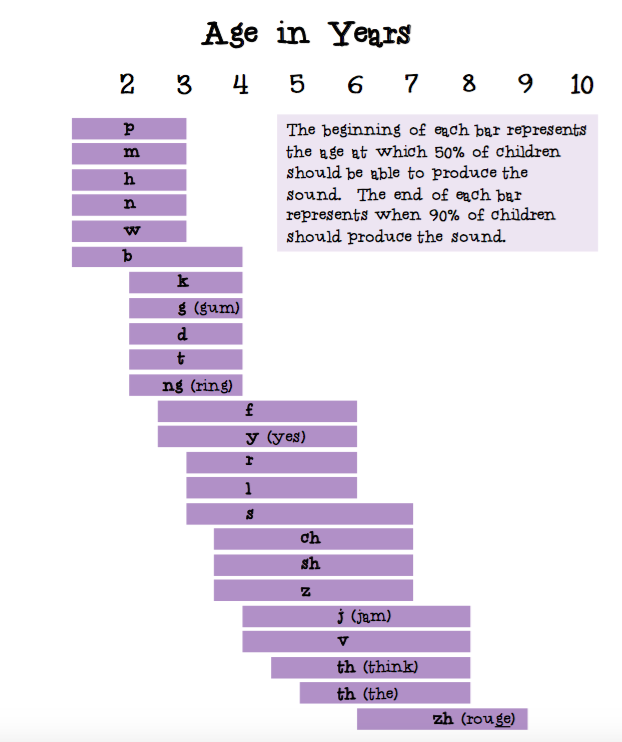
Support this browser is being discontinued for Pregnancy, Birth and Baby
Support for this browser is being discontinued for this site
- Internet Explorer 11 and lower
We currently support Microsoft Edge, Chrome, Firefox and Safari. For more information, please visit the links below:
- Chrome by Google
- Firefox by Mozilla
- Microsoft Edge
- Safari by Apple
You are welcome to continue browsing this site with this browser. Some features, tools or interaction may not work correctly.
Early speech development of young children
"... in the community, under guidance, with the help of a child can always do more and solve the most difficult problems than on their own." A.V. Zaporozhets, a well-known Russian psychologist.
I want to draw the attention of parents to a very important period in the development of the baby, which we call "pre-speech".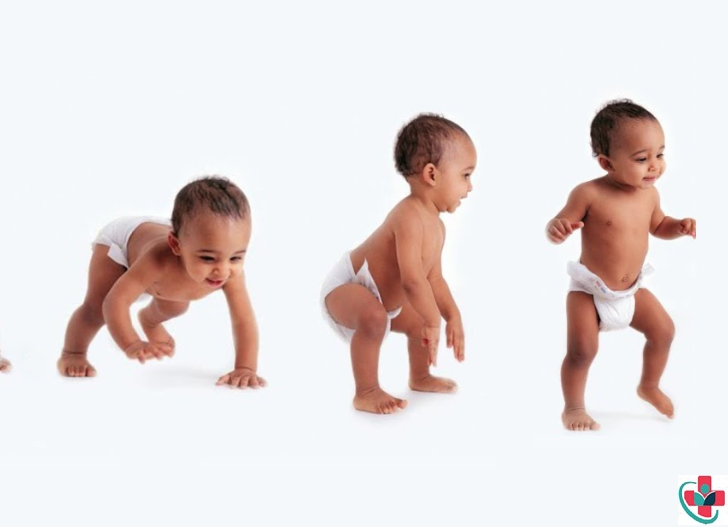 It is during this period that the baby is preparing for further speech development, which is not yet noticeable, but is already very actively taking place. From my many years of experience, I know that many mothers pay little attention to the cooing and babbling of the baby, many do not even know what it is and how they differ.
It is during this period that the baby is preparing for further speech development, which is not yet noticeable, but is already very actively taking place. From my many years of experience, I know that many mothers pay little attention to the cooing and babbling of the baby, many do not even know what it is and how they differ.
But the first symptoms of trouble can manifest themselves precisely during this period, when the child's nervous system is still very plastic and pliable to therapeutic effects. You should also not make preliminary diagnoses, because we are adults too, very different. Someone is talkative, someone is called a "silent person", one cannot live without communication, and the other likes to be alone. And our children are ours and, of course, they look like us. Along with the norm, I give examples that, in combination with other symptoms, should alert parents.
Often there is nothing serious behind these symptoms, only a slight correction is needed. Mothers with perfectly healthy children come to see me, who had features of babbling and cooing.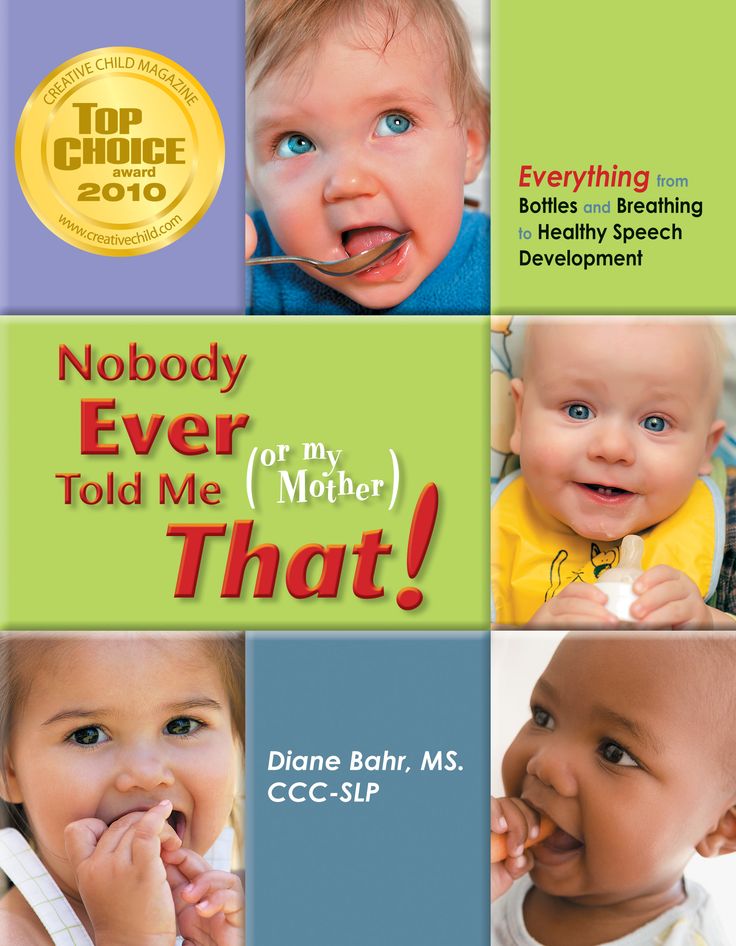 Yes, not everyone who had deviations in pre-speech development later developed problems with speech and reading, very often everything returned to normal. But all children with speech difficulties necessarily had violations of early speech and pre-speech development.
Yes, not everyone who had deviations in pre-speech development later developed problems with speech and reading, very often everything returned to normal. But all children with speech difficulties necessarily had violations of early speech and pre-speech development.
Stages of pre-speech development
- The first year of life is called the period of pre-speech development, during which preparation for mastering speech takes place. From the very first day of life, the child is preparing for speech. From the moment of birth, there are voice reactions - screaming and crying. With these signals, the baby reports that he is ill, he is hungry, sick. A healthy newborn makes separate sounds, intermediate between "a" and "e".
- Pay attention if the baby sobs on sigh, with a characteristic nasal tint, or there is a piercing, painful, continuous cry, which is commonly called "brain". If these symptoms do not go away, you should consult a specialist.
- Gradually, the child learns to listen to his speech and the speech of others.
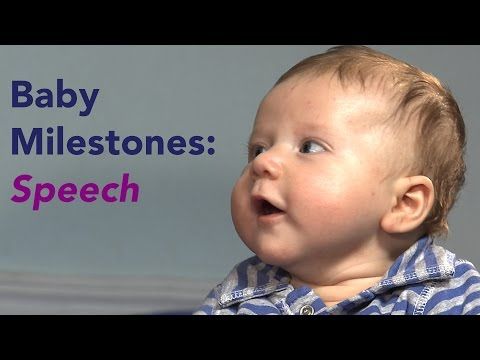 From the 1st month, the baby calms down when he hears a lullaby. An increased interest in human speech in the form of a concentration reaction appears at 4-5 weeks. When an adult bends over a child, gently talks to him, he stops crying and moving, “listens”. At 5-8 weeks, in response to the speech of an adult, the child smiles, from 8 weeks - a real smile, by 9-12 weeks laughter appears. Starting from 6-8 weeks, in response to an attempt by an adult to make contact, the baby utters separate sounds - cooing (initial cooing). True humming or melodious humming appears on the 2-3rd month. The child, being in a calm state, makes long vowel sounds.
From the 1st month, the baby calms down when he hears a lullaby. An increased interest in human speech in the form of a concentration reaction appears at 4-5 weeks. When an adult bends over a child, gently talks to him, he stops crying and moving, “listens”. At 5-8 weeks, in response to the speech of an adult, the child smiles, from 8 weeks - a real smile, by 9-12 weeks laughter appears. Starting from 6-8 weeks, in response to an attempt by an adult to make contact, the baby utters separate sounds - cooing (initial cooing). True humming or melodious humming appears on the 2-3rd month. The child, being in a calm state, makes long vowel sounds. - With certain pathologies of the nervous system, the child may not show interest in the speech of an adult, not respond to surrounding objects. In children in such cases, negative reactions usually predominate (monotonous crying, prolonged crying on one tone), a smile is extremely rare, and there is no cooing.
- By 5-6 months, the nature of the sounds becomes more complicated.
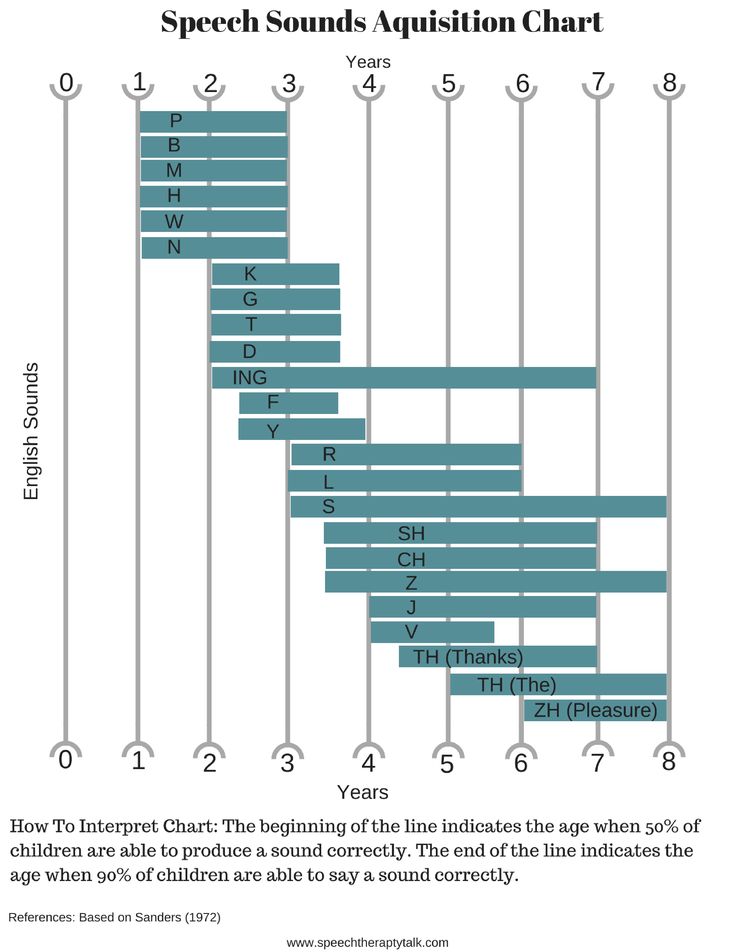 Combinations appear: “baaa, maaa”, “taaa, paaa”. Observing the child, it can be noted that at the moment of pronouncing sounds, he slows down his vocal movements, as if listening and imitating himself, pronounces sounds in the form of chains. By about the 5th month of life, sound and syllabic pronunciation begin to acquire some semblance of words. By 5-6 months, the cooing gradually turns into clear and distinct speech sounds, babble appears. The first babble consists of short chains of syllables: ba-ba-ba, ma-ma-ma. Parents sometimes take such babble chains for meaningful speech, but these, of course, are not words yet.
Combinations appear: “baaa, maaa”, “taaa, paaa”. Observing the child, it can be noted that at the moment of pronouncing sounds, he slows down his vocal movements, as if listening and imitating himself, pronounces sounds in the form of chains. By about the 5th month of life, sound and syllabic pronunciation begin to acquire some semblance of words. By 5-6 months, the cooing gradually turns into clear and distinct speech sounds, babble appears. The first babble consists of short chains of syllables: ba-ba-ba, ma-ma-ma. Parents sometimes take such babble chains for meaningful speech, but these, of course, are not words yet. - Children with a lack of cooing, low expressiveness of speech, and a lack of imitation deserve special observation. A child with initial signs of early childhood autism may be clearly non-contact, passive, orienting reactions will be reduced or, conversely, physical activity, anxiety, negative emotional reactions to new objects (crying, screaming) will prevail.
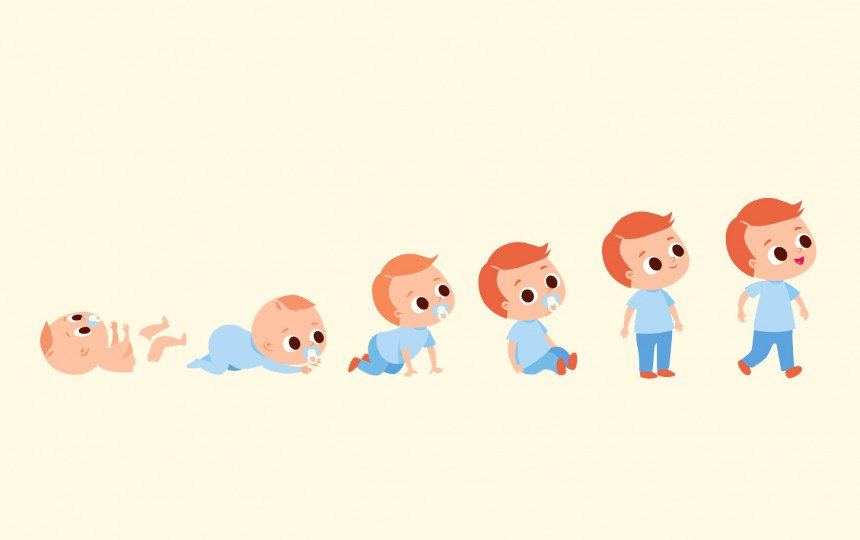
- By 9 months babbling is enriched with new sounds, intonations, develops into long rows of syllables. Babble becomes a constant response to the adult's voice appeal and accompanies various actions with objects and toys. AT 9months, the child demonstrates understanding of the speech addressed to him, reacts to his name, perceives some simple verbal instructions and responds to them with an action: “open your mouth”, “give a pen”, press your cheek to the mother at the request “kiss mom”, raise your head and eyes to the lamp to the question “where is the light?”, they are looking for a toy hidden in front of their eyes, at the word “no” they stop reaching for any object, or stop pulling it into their mouth, etc. Children 9-10 months old are characterized by active babbling, consisting of 4-5 syllables or more. The child repeats new syllables after the adult, which he himself has not previously pronounced, copies the intonation well, accompanying it with expressive facial expressions and gestures.
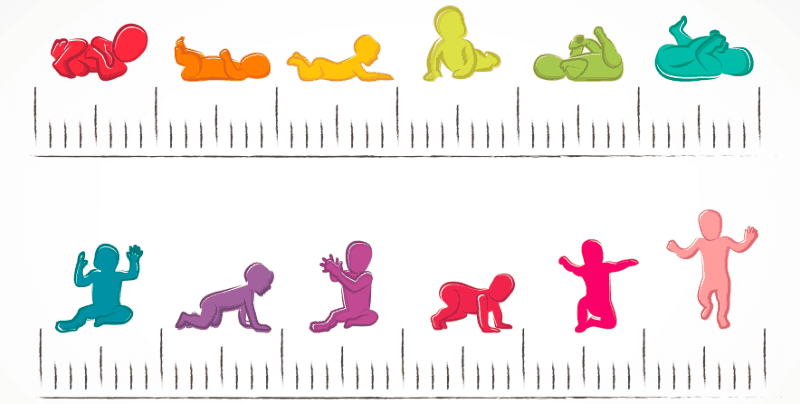 By 9-10 months he pronounces separate words consisting of the same paired syllables (mom, dad).
By 9-10 months he pronounces separate words consisting of the same paired syllables (mom, dad). - A child of 11-12 months increasingly pays attention to the face of the speaker, begins to nod his head as a sign of affirmation and shake it as a sign of denial. The syllables included in the babbling become components of the words: ma-ma-ma - “mother”. The kid begins to designate certain objects with sound combinations, for example: car - “beep”, etc. At the same time, children of this age usually show a new interest - looking at picture books. Recognizing familiar objects in pictures or showing them at the request of an adult, children designate them with babble words.
- By the year, the dictionary usually reaches 8-10, and sometimes more "words" (baba, kitty, mu, be, etc.), which have a specific meaning. By the age of 1, the child understands and follows 5-10 simple instructions: “bring this”, “close the door”, “give me a cup”, etc. Thus, in the first year of life, the child is preparing the speech apparatus for the pronunciation of sounds.
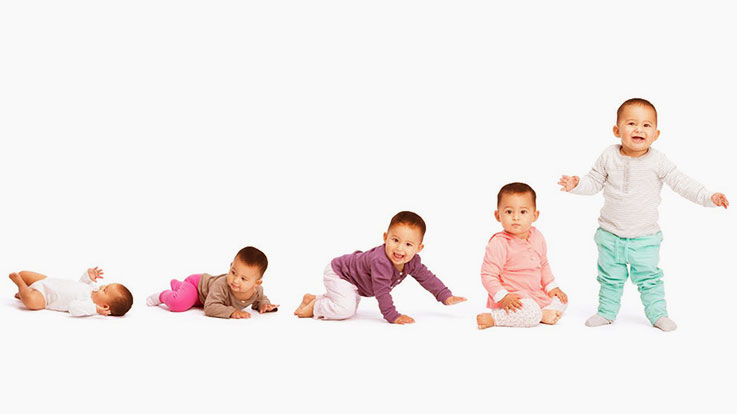 At the same time, there is an active process of developing speech understanding.
At the same time, there is an active process of developing speech understanding.
What to do for a mother
“Infecting” the baby with positive emotions, the mother stimulates his interest in the outside world, and since the satisfaction of this interest is associated with the expenditure of physiological resources, she stimulates in a certain direction both metabolic processes and differentiation of tissues in the body of her baby . On the contrary, by conveying negative emotions to an infant, we suppress not only his interest in the outside world, but also certain biological processes in his body. It is not better when the adults around the child "infect" him with too strong affective emotions.
These energy-intensive emotions drain the child's nervous system and can lead to somatic illnesses. The adult's mechanical fulfillment of routine moments, his indifferent, indifferent attitude towards a small child excludes the possibility of any kind of emotional contact at all.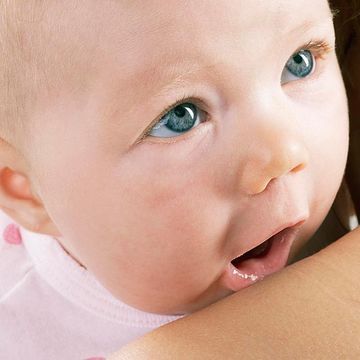 With such an adult, the child does not have the need to communicate, and therefore the cognitive experience does not develop and the necessary communicative and cognitive means are not formed. There is a threat of mental retardation and a disorder in the further interaction of the child with an adult. The child's brain develops incorrectly or is delayed, in the absence or deficiency of external stimuli.
With such an adult, the child does not have the need to communicate, and therefore the cognitive experience does not develop and the necessary communicative and cognitive means are not formed. There is a threat of mental retardation and a disorder in the further interaction of the child with an adult. The child's brain develops incorrectly or is delayed, in the absence or deficiency of external stimuli.
And vice versa: interest in an adult, curiosity about the outside world and communicative-cognitive activity are caused and supported, as we have seen, by positive emotions emanating from an adult. Therefore, we can repeat once again that for infancy, the emotional communication of a child with an adult is not a luxury, but a prime necessity, a condition for the formation of his psyche according to a human social type. Depriving the infant of the emotional attention of an adult leads at this early age primarily to abnormal development of the child's personality.
If parents have noticed trouble, and this is not one symptom, but several (lack of babbling, cooing, change in voice, behavior), then you should contact a specialist.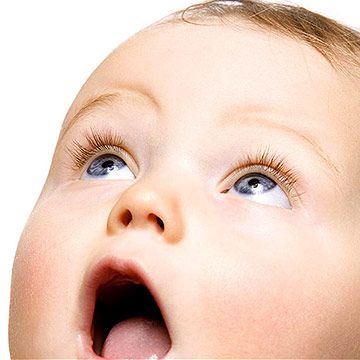 And then, along with speech therapy correction (massage, articulatory gymnastics, stimulation of voice reactions), drug treatment, physiotherapy, etc. are prescribed.
And then, along with speech therapy correction (massage, articulatory gymnastics, stimulation of voice reactions), drug treatment, physiotherapy, etc. are prescribed.
How to stimulate speech development specialists, the better the results will be: the reserve capabilities of the brain are especially high at an early age, during the period when speech is actively developing.
At the stage of pre-speech development (1-3 months) it is necessary to encourage motor and communication functions, develop and reinforce the child's need to communicate with adults, strengthen the ability to fix the gaze and follow a moving object. Gradually move on to active stimulation of fine motor skills. In the absence of cooing at this stage, violation of voice reactions, the doctor may prescribe, along with the use of drug therapy, speech therapy correction (facial massage, breathing and articulation exercises). At the 3rd stage of pre-speech development (3-6 months), the baby manipulates toys, pulls them into his mouth, rolls over and crawls to an object that interests him, throws toys and follows their movement. In cases where there is a delay in pre-speech skills, it is advisable to conduct their purposeful stimulation. For example, create situations that cause a child to laugh, coo, as imitation reactions. If necessary, speech therapy correction may consist of active speech therapy massage, activities aimed at the development of babbling. At the 4th stage (6-9months) and the 5th stage (9-12 months), the possibilities of speech therapy assistance are expanding.
In cases where there is a delay in pre-speech skills, it is advisable to conduct their purposeful stimulation. For example, create situations that cause a child to laugh, coo, as imitation reactions. If necessary, speech therapy correction may consist of active speech therapy massage, activities aimed at the development of babbling. At the 4th stage (6-9months) and the 5th stage (9-12 months), the possibilities of speech therapy assistance are expanding.
Along with active massage and gymnastics, tongue movements, chewing movements, and lip movements begin to be stimulated. Stimulate the ability to recognize the intonation coloring of addressed speech. Babble and initial syllable formation are stimulated with the help of appropriate imitative or imitative games (“Okay”, “Goodbye”, “Geese flew - sat down on their heads ..”, etc.) The effectiveness of speech therapy correction of pre-speech disorders cannot be carried out without active stimulation of mental development. After 6 months, the child is stimulated with purposeful actions with various objects, stimulation of repeated actions, object-effective communication with adults.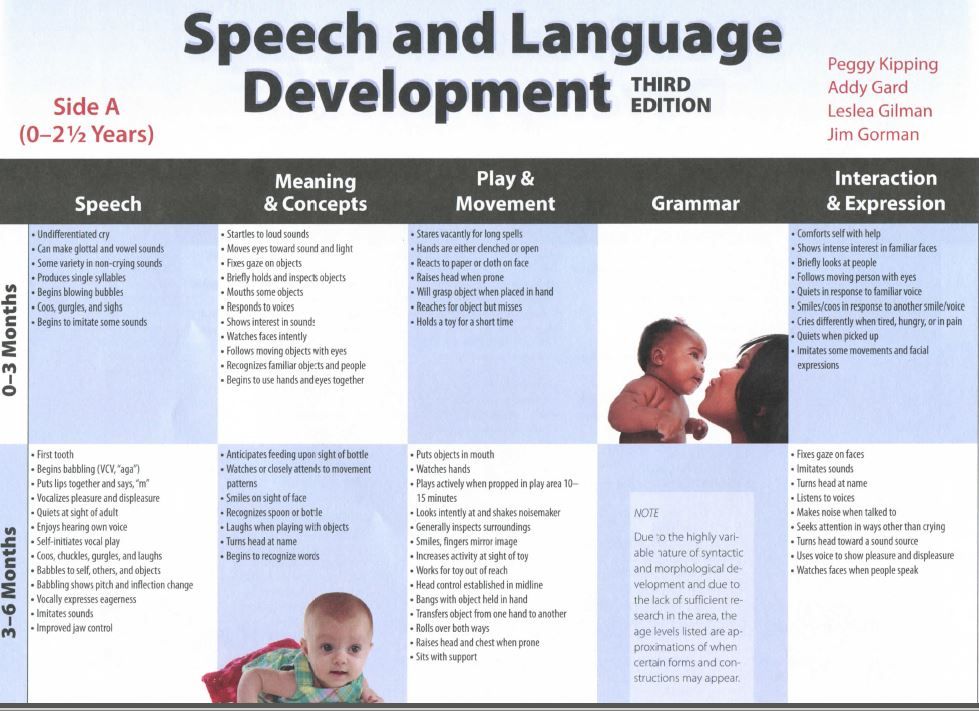 From the second half of a child's life, they are taught to handle objects and manipulate them.
From the second half of a child's life, they are taught to handle objects and manipulate them.
Sound pronunciation
- The pronunciation side of a child's speech can be judged only when he has accumulated a significant vocabulary. The time and order of the appearance of sounds in different children is not the same. In the third year of life, the child has the right to incorrect sound pronunciation. So, whistling sounds (S, Z, Z ', C), hissing (Sh, Zh, Ch, Shch) and sonorous (R, R ', L) he usually skips or replaces (S-S '; Z-S ' , V; C-T'; W-S', T'; W-S', D'; Ch-T'; SH-T'; R-L'; R'-L'; L-L')
- If any violations of the pronunciation side of speech are found in infants, it requires timely corrective measures, additional examinations by other specialists. The prospects for mental development, the success of teaching children with disabilities in neuropsychic development, their school and social adaptation depend on the early detection of disorders in cognitive activity.
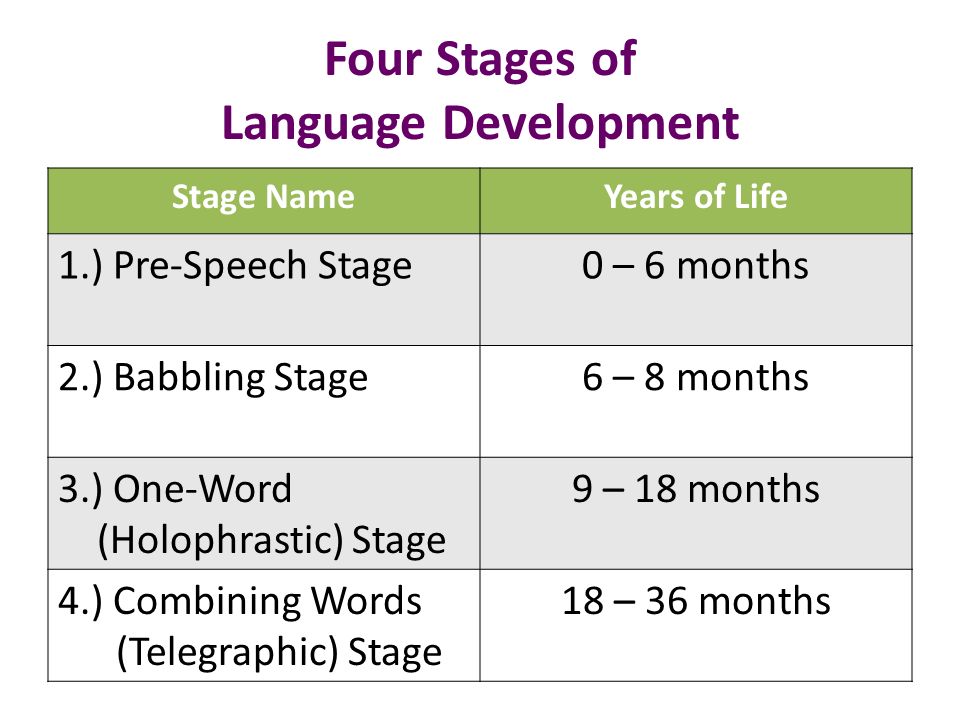 But often speech therapists in the clinic advise you to wait a bit - "don't come before 5 years." This can be explained by the fact that classes with a baby require a special individual approach, and not every specialist has the necessary knowledge, experience, and most importantly, the desire to work with young children. But a good speech therapist won't brush off anxious parents.
But often speech therapists in the clinic advise you to wait a bit - "don't come before 5 years." This can be explained by the fact that classes with a baby require a special individual approach, and not every specialist has the necessary knowledge, experience, and most importantly, the desire to work with young children. But a good speech therapist won't brush off anxious parents. - In the absence of active speech in a 1.5-3-year-old child, it is necessary to arrange an appointment with competent specialists: a neurologist, psychologist, speech therapist, otorhinolaryngologist, and conduct a series of diagnostic studies. Parents should be alarmed by speech delays not only when the child does not have speech at two years old, but also in cases where development is delayed or there is a complete absence of cooing and babble. Observations of specialists and objective data from medical studies will clarify the nature of the violation, the degree of its complexity, suggest possible causes of occurrence and organize adequate assistance to the child.
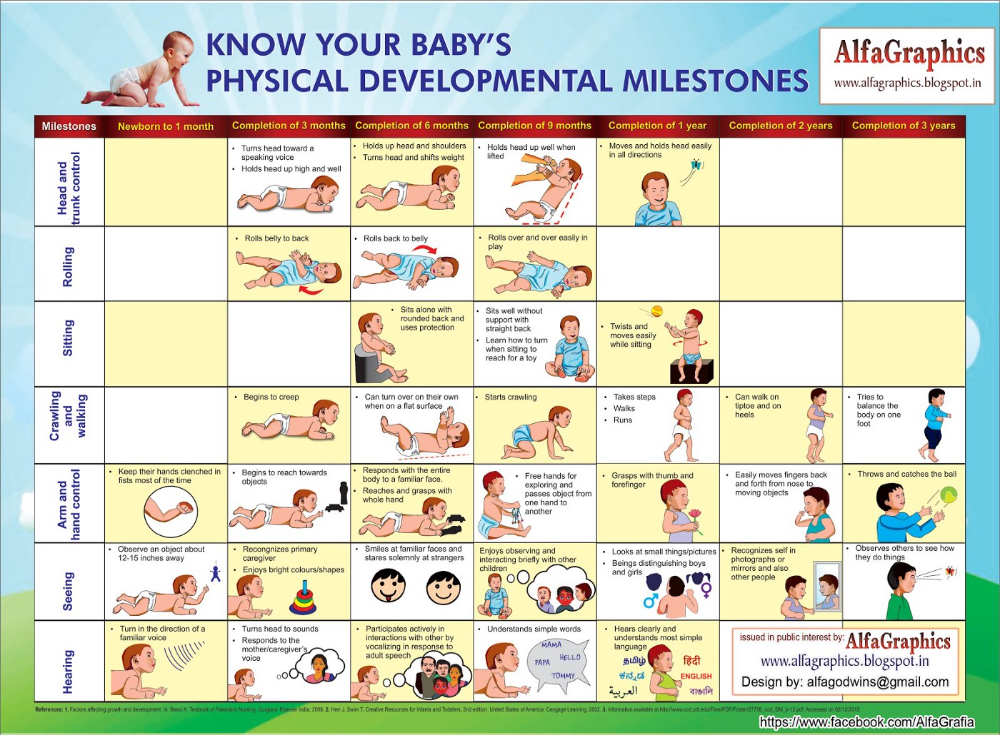
- At any age, speech disorders limit cognitive activity and the possibility of social adaptation of a person. Consultations of competent specialists and remedial classes with speech pathologists will help to distinguish speech disorders from other disorders (mental retardation, mental retardation, hearing impairment, autism spectrum disorders), and make a more accurate diagnosis. Early correction, conducting systematic speech therapy classes, which in essence are a well-organized game, can completely compensate for a speech defect.
- The importance of speech development at an early age is great: speech, along with intelligence, is an important indicator of the development of the baby, and its violations are evidence of ill health in the mental sphere. Speech reflects the success (or failure) of mastering the native language, the main social acquisition of the child during this period.
- The speech of a young child reflects the development and lays the foundations for future higher mental functions: memory, attention, thinking, and hence all further education of the child, and ultimately his social adaptation and success.
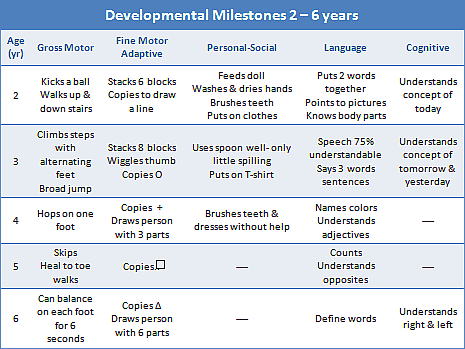 That is why in correctional and developmental work with young children, special attention is paid to the stimulation (formation) of speech activity.
That is why in correctional and developmental work with young children, special attention is paid to the stimulation (formation) of speech activity.
About the organization of classes
The development of a child's speech occurs at every moment of his life. Everyday situations, including getting ready for bed, washing, eating take place almost in the same conditions. This helps to enrich the vocabulary of children and consolidate speech skills. Appeal to children on various occasions forms their need for communication. At the same time, it is necessary to actively use play and everyday situations that are pleasant for the child. For example, when washing or bathing a child, you can sing a composed song on the go, drawing the baby’s attention to the parts of the body and the face that it sings about with a gentle touch:0004
- Where, where, where, where, where, where are our pens? (2 times)
- Here they are, here they are, here are our pens. (2 times)
- Where, where, where, where, where, where are our legs? (2 times)
- Here they are, here they are, here are our legs.
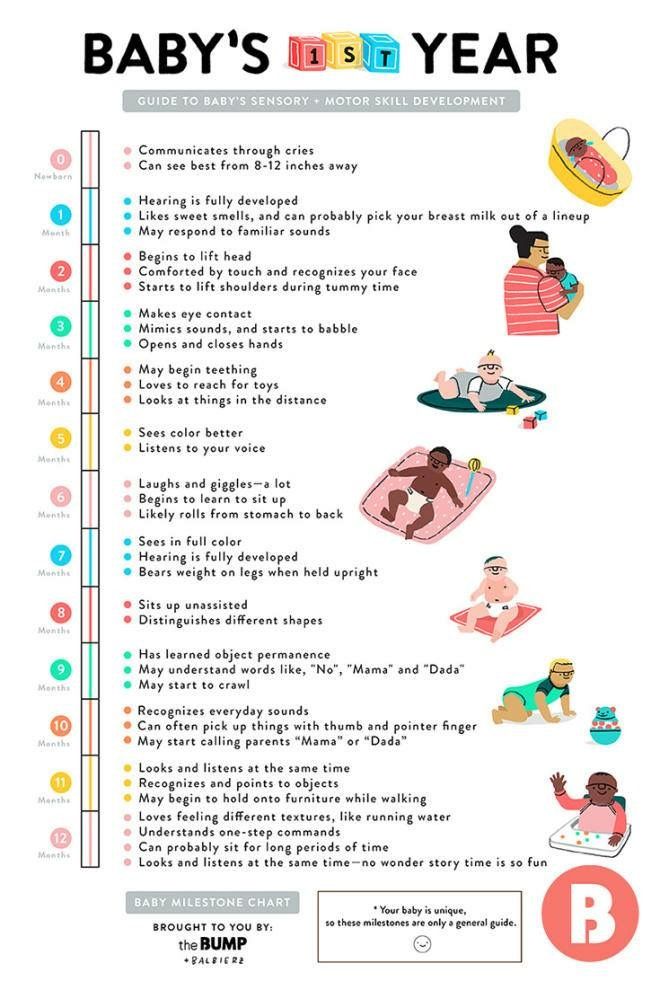 (2 times)
(2 times) - Where, where, where, where, where, where is our tummy? (2 times)
- Here it is, here it is, here is our tummy. (2 times)
- Where, where, where, where, where, where are our eyes? (2 times)
- Here they are, here they are, here are our eyes. (2 times)
- Where, where, where, where, where, where are our cheeks? (2 times)
- Here they are, here they are, here are our cheeks. (2 times)
The gentle voice of the mother, pleasant stroking movements will stimulate the child's independent vocal reactions.
Just communication with the baby in everyday life is not enough for his development. It is necessary to use speech in subject and game activities. It is also desirable to conduct specially organized classes (games-classes). It is important to bear in mind that at an early age all the tasks that are given to the child should be offered as an entertaining and interesting game. Only against a positive emotional background does the baby himself want to pronounce a new word, repeat a combination of sounds or a phrase he heard.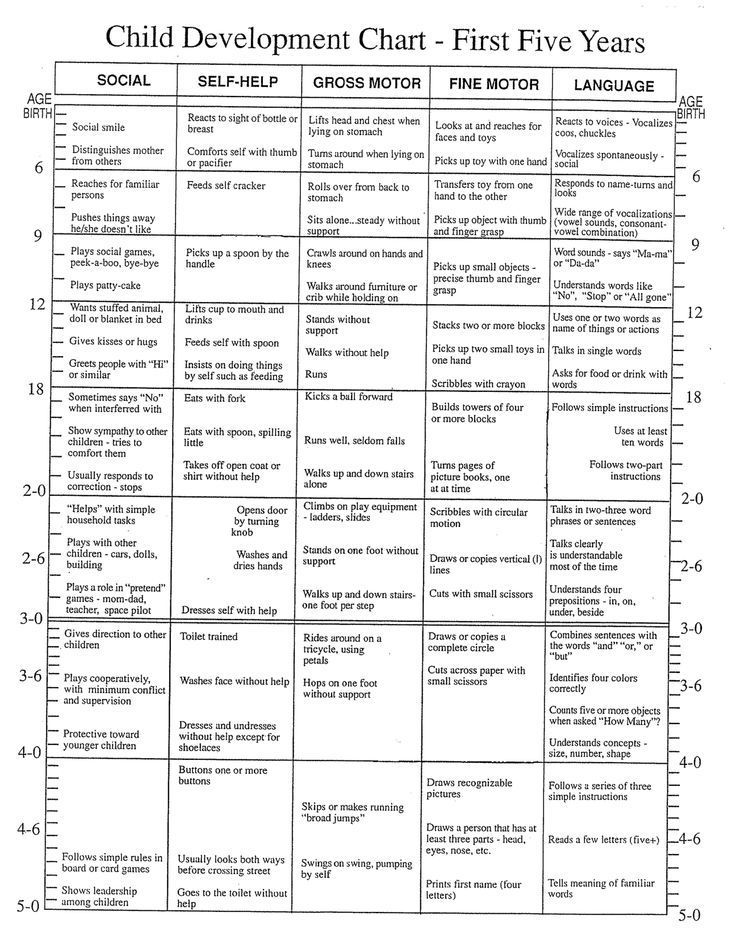
When learning new words, always use the toy or object first and then the picture. If a child easily recognizes and names familiar objects and toys, one should gradually move on to working with subject and plot pictures.
Speech therapist, neurodefectologist Elena Gennadievna Timoshchenko, author of the series of lectures of the Territory of Health "Early development of speech and intelligence of a child".
crying, cooing, babbling, first words
Speech development of a child under 1 year old by months. Consider all the stages from birth: crying, cooing, babbling, the appearance of the first words. You will learn what is the norm and what is pathology, how you can stimulate the early speech development of the child.
Speech is the highest mental function, which is the basis of thinking, and not just a means of communication. It allows the crumbs to analyze and classify their impressions of the world around them, to make generalizations and conclusions.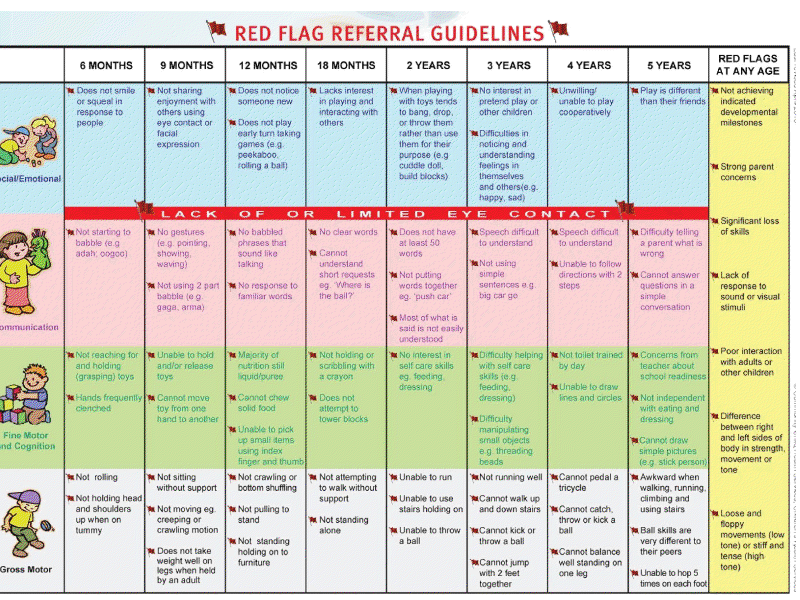 It is not for nothing that parents and specialists attach such importance to the development of speech in babies.
It is not for nothing that parents and specialists attach such importance to the development of speech in babies.
Article content:
- Stages of speech development up to a year
- Monthly speech development norms
- Stimulation of early speech development
- Deviations from the norm
Stages of speech development up to a year
The development of a child's speech from birth to a year is conditionally divided into four stages of uneven timing. The rate of development in infancy may differ slightly over time, but the indicated periodization allows us to separate the norm from the pathology.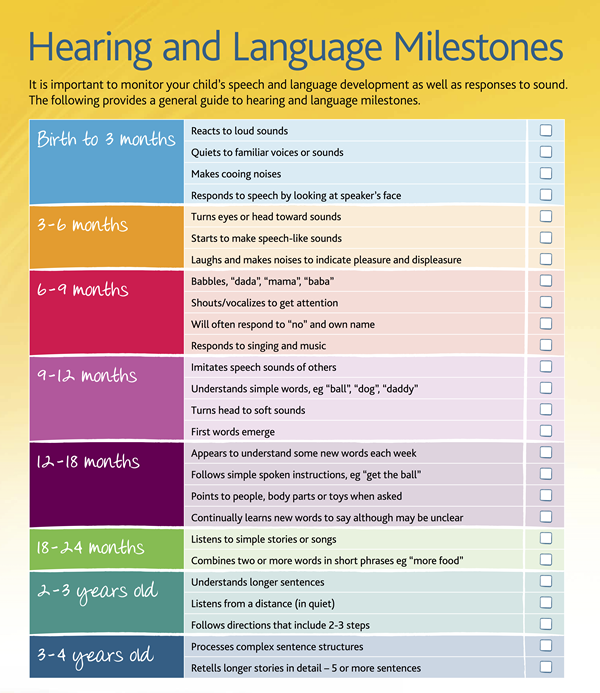
Stages of speech development of a child up to a year:
- The crying stage lasts from birth to 6-8 weeks. The cry and sounds made by the baby are reflex sounds. Most often these are vowel sounds with a nasal tinge. A short inhalation and a long exhalation are accompanied by a loud cry.
- The cooing stage of lasts from two to five months. The cry of the child acquires intonational coloring, changes depending on the condition of the baby. Hooting sounds and their combinations with vowels can occur both spontaneously and when communicating with an adult (the child begins to say agu, gy, khy, aha, ha, ege, aa). The developmental stage is accompanied by the appearance of a smile for everyone who communicates with the child, a little later - the first laugh, similar to squealing. Cooing occurs on exhalation - this is how speech breathing is trained.
- The babbling stage lasts up to 10-11 months. 6-7 months is the period when a baby babbles.
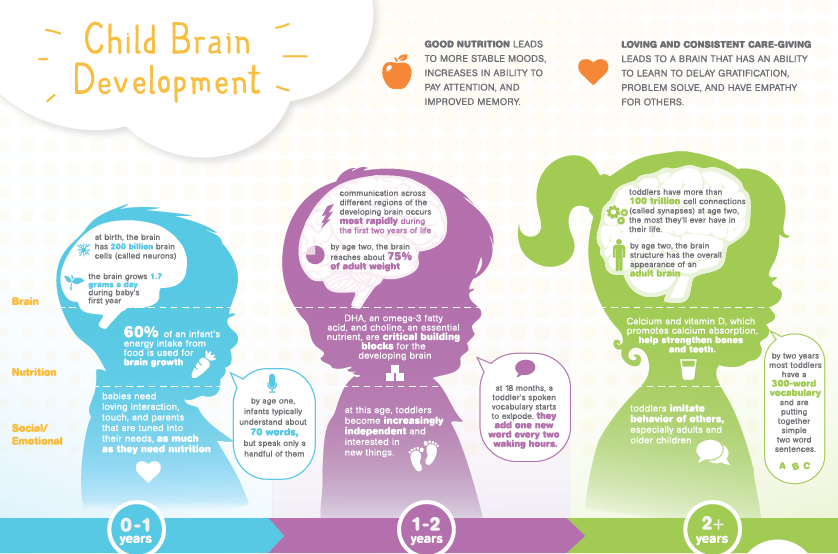 The beginning of this stage is characterized by a simple babble, consisting of individual syllables (pa, ba, la), later turning into syllabic chains (pa-pa-pa, ba-ba-ba, la-la-la). The oral cavity becomes more perfect, the tongue has the ability to perform a variety of movements. This makes it possible for a child to pronounce various sound complexes similar in sound to syllables with a vowel at the end: ma-ma-ma, pa-pa-pa, yes-yes-yes, nya-nya-nya.
The beginning of this stage is characterized by a simple babble, consisting of individual syllables (pa, ba, la), later turning into syllabic chains (pa-pa-pa, ba-ba-ba, la-la-la). The oral cavity becomes more perfect, the tongue has the ability to perform a variety of movements. This makes it possible for a child to pronounce various sound complexes similar in sound to syllables with a vowel at the end: ma-ma-ma, pa-pa-pa, yes-yes-yes, nya-nya-nya. - The stage of the first words comes at the end of the first year of life. At this stage, the child begins to correlate babbling complexes with specific words. He does not just pronounce a chain of syllables ma-ma-ma, but correlates the word ma-ma with a real object, reacts to the appearance of dad with the word pa-pa. The first words of the child consist of two identical syllables (pa-pa - dad, ba-ba - grandmother, la-la - doll). The understanding of addressed speech is intensively developing, the baby actively begins to accumulate a passive vocabulary.
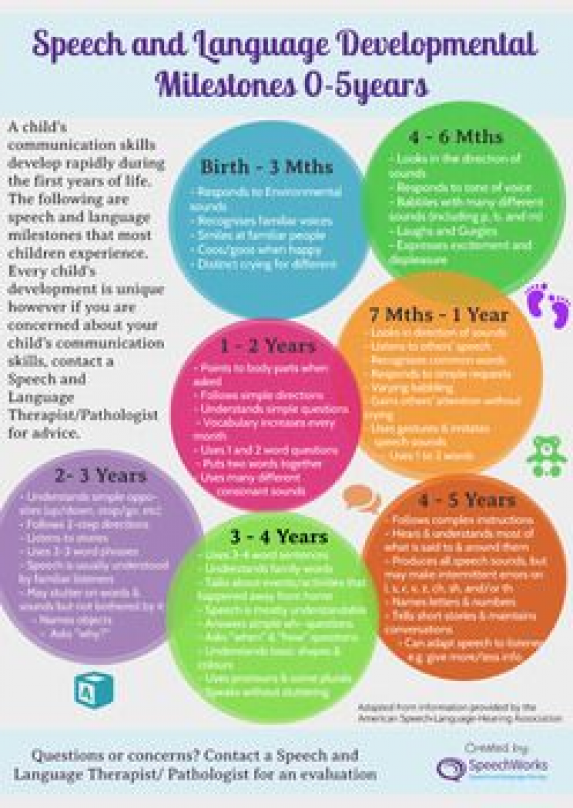 He can't say "donkey" yet, but if you ask for a donkey toy, he will.
He can't say "donkey" yet, but if you ask for a donkey toy, he will.
One of the results of the development of speech in the first year of life is the understanding of the meanings of a large number of words denoting action. The child understands not only the designations of large movements (stand, run, eat), but also words meaning small actions performed by the hand (open your fist, give your hand, show what is in your hand, let go).
Speech development norms by months
The stages of infant speech development described above have a more detailed division to determine the norm or pathology. Indicators of the norm may slightly shift depending on the individual characteristics of the baby and the conditions of its growth. It is known, for example, that each serious illness suffered by a young child "throws" him a little back in terms of the development of skills and abilities. This applies to both boys and girls.
The development of the child's speech by months is normal:
- The first month and a half of life.
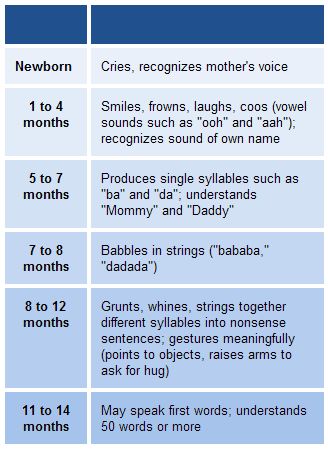 There are sounds with which the child reacts to the speech of the mother and other close people addressed to him. These are mainly vowel sounds and their combinations (o, a, y, i, ay, wah). The child is able to focus on the faces of relatives, on the toys shown to him, to listen to the sounds of human speech. During this period, children with prerequisites for a future speech disorder can be identified by assessing the nature of their cry - piercing or very quiet, sobbing or screaming on inspiration is possible, and not on exhalation, as is normal development.
There are sounds with which the child reacts to the speech of the mother and other close people addressed to him. These are mainly vowel sounds and their combinations (o, a, y, i, ay, wah). The child is able to focus on the faces of relatives, on the toys shown to him, to listen to the sounds of human speech. During this period, children with prerequisites for a future speech disorder can be identified by assessing the nature of their cry - piercing or very quiet, sobbing or screaming on inspiration is possible, and not on exhalation, as is normal development. - On 2-3 months "complex of revival", consisting of characteristic movements of the arms and legs at the sight of the mother, accompanied by guttural sounds and their combinations with vowels (a-a-a, a-a-gi, a-a-gu , a-ha). Such gooking occurs not only when in contact with familiar close people. It can occur spontaneously when the baby is full and happy, or when looking at a toy. Another achievement of this stage is auditory and visual concentration on the source of sound or movement.
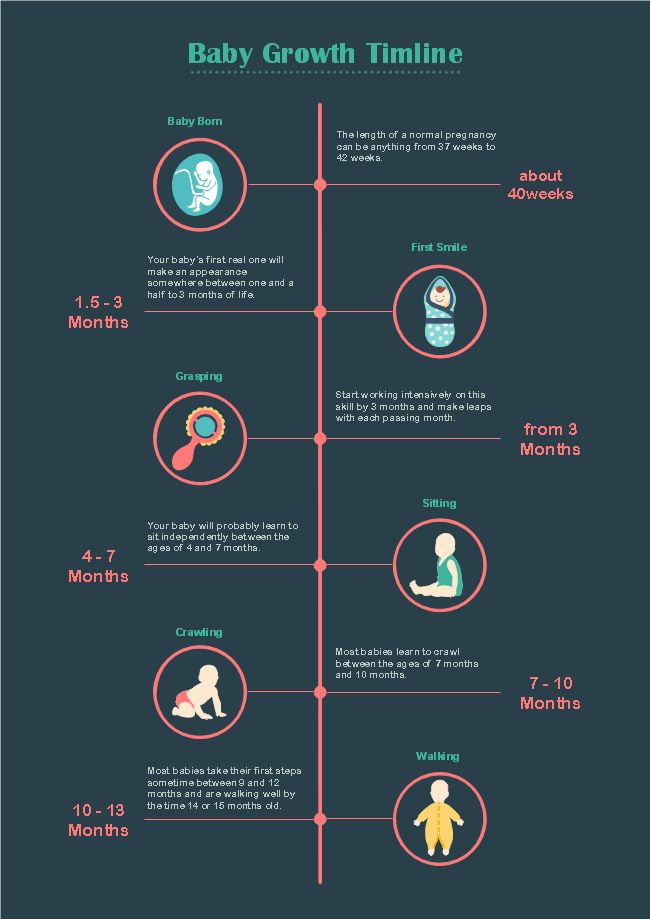
- At 3-5 months the child is looking for contact with adults with his eyes, smile, utters drawling sounds - hums. They most often consist of such sound combinations as gy, khy, agu, aha, ha, ege, aa. Sometimes these combinations are so bizarre that they are difficult to reproduce. Pathology at this stage are monotonous sounds of cooing, accompanied by chaotic movements of the arms and legs, the lack of intonational expressiveness.
- At 6 months of life, babble appears in the child's speech, consisting of such combinations of sounds as "ha, ka, pa, ma". Constantly repeating, they already become quite similar to word models, as if pronounced in syllables: “ma-ma-ma-ma, ba-ba-ba”. Such improvisations appear only in a good mood, and so far they cannot be a means of communication. During this period, congenital deafness can be diagnosed, because a deaf child does not babble, the sounds of humming gradually fade away.
- On 7th month there is a connection between the object and the word denoting it.
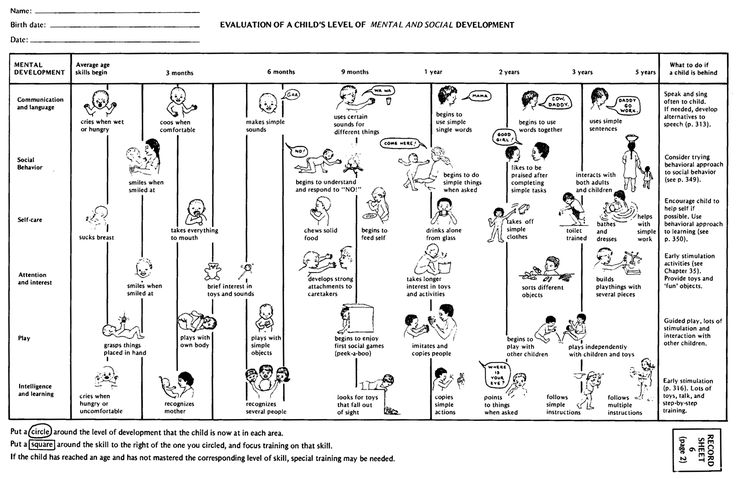 If parents specifically pay attention to this skill, show objects and toys, naming them several times, then the child will quickly learn to look for them with a glance at the request of an adult. Words must be clearly distinguishable in sound. In a child with delayed speech development, babble is absent or manifested by separate elements, the baby does not imitate the movements of an adult, does not follow the simplest verbal commands.
If parents specifically pay attention to this skill, show objects and toys, naming them several times, then the child will quickly learn to look for them with a glance at the request of an adult. Words must be clearly distinguishable in sound. In a child with delayed speech development, babble is absent or manifested by separate elements, the baby does not imitate the movements of an adult, does not follow the simplest verbal commands. - After 9 months the child's active vocabulary contains between 10 and 25 words. Along with correctly pronounced words (dad, baba, uncle, lala), these can be babbling words (am, bobo, bang), and partially pronounced forms of words (“kach” - swing, “zya” - you can’t), as well as onomatopoeia of animal voices and ambient sounds (meow, ha-ha, bi-bi). By this time, a connection has already been established between the word and the object that it denotes. Speech by the end of the first year of life is the main means of communication of the child with adults.
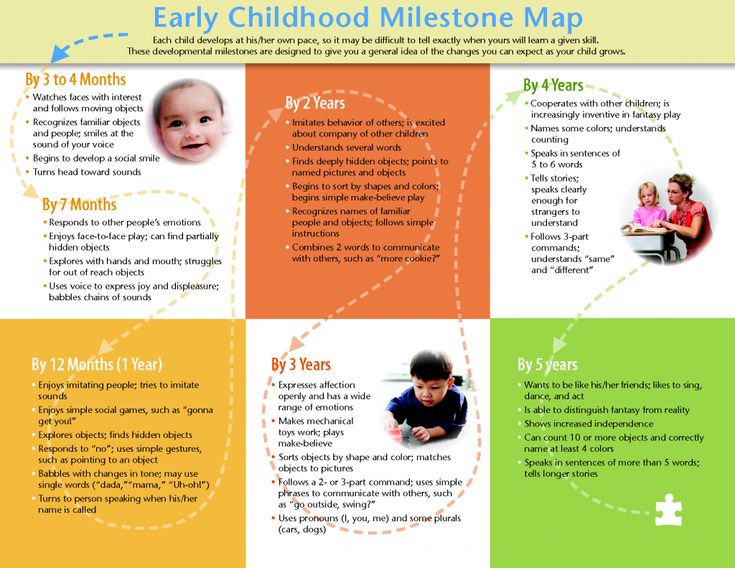
In this sequence, the speech of the baby develops. You should be wary if he prefers instead of words to express his desires with gestures, facial expressions and lowing. In a one-year-old child, such manifestations are not considered a deviation from the norm if words are also used in communication.
Stimulation of early speech development
The early speech development of a child is directly related to the formation of the brain in the prenatal period. Therefore, a lot depends on the normal course of pregnancy and childbirth.
Stage of pregnancy
The development of the brain structures of an unborn baby can be affected by a genetic predisposition to hereditary pathologies of fetal development, stressful overload of the mother during pregnancy, exposure to nicotine and alcohol, and malnutrition of the mother. This also includes a lack of oxygen (hypoxia) in a child during pregnancy and childbirth, a negative Rh factor, the negative effect of infections and chronic pathologies.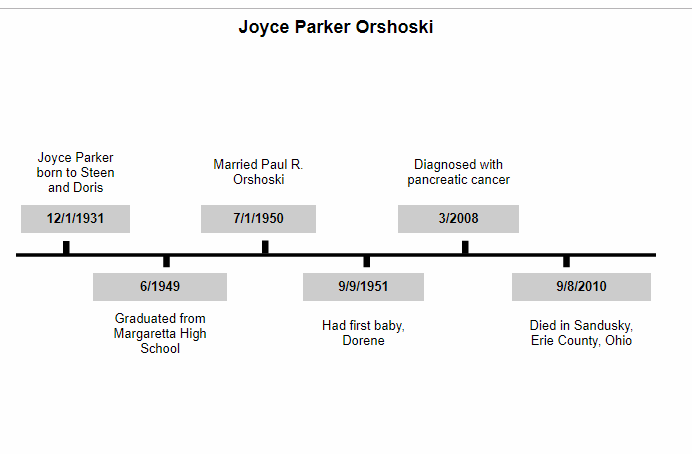
The process of intrauterine development of the brain has a very important feature - its neural connections and structures develop not only under the influence of heredity genes, but also under the influence of information flows coming through still immature, but still active sense organs.
An unborn baby is able to hear the sounds of the surrounding world and the mother's heartbeat, feel her movements. Women who, even before the birth of a baby, read fairy tales to him, talk to him, and listen to good music together do the right thing.
After the baby is born
Talk to the newborn when feeding, dressing, hygiene procedures. This is how the meaning of words denoting objects and actions is conveyed to him. Even without understanding the meaning of the words of the parents, the baby catches the emotional coloring of the speech. He realizes that they are addressing him, there is a desire to answer. Those mothers and fathers who talk with the baby from the first days of his life are right.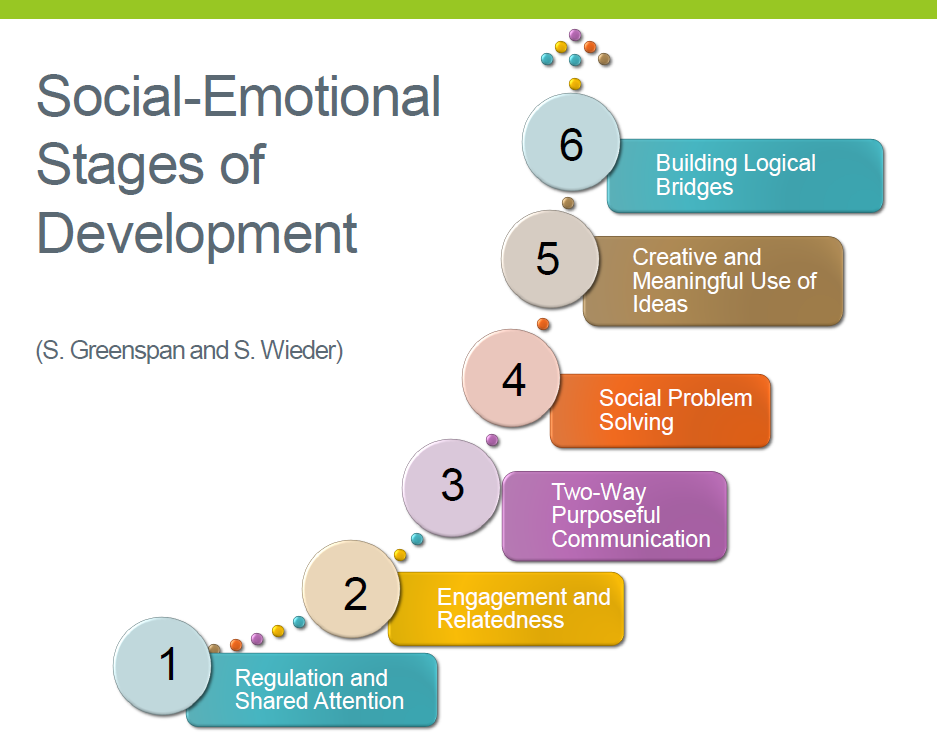
Even in the first year of life, a normally developing child has access to a feature of speech - to understand that different objects are called in one word. “Kisa” is both a live cat, a soft toy, and a porcelain figurine behind a cabinet glass. The BBC is a real car, a plastic car on a string, and a picture in a children's book. The ability to understand generalizing words can be developed by the end of the first year by parents tirelessly acquainting the baby with various objects and phenomena of his environment. It is necessary to comment on everything that happens around the child.
Speech development is a process closely related to the development of the baby's sensory abilities. Sensory education is the development of perception, discrimination of the shape and color of surrounding objects. Sensory abilities need to be developed from the first days of a baby's life, surrounding him with expressive interior items and toys. For the development of hearing, you can often offer him harmoniously sounding toys, musical instruments, emotionally communicate with the child.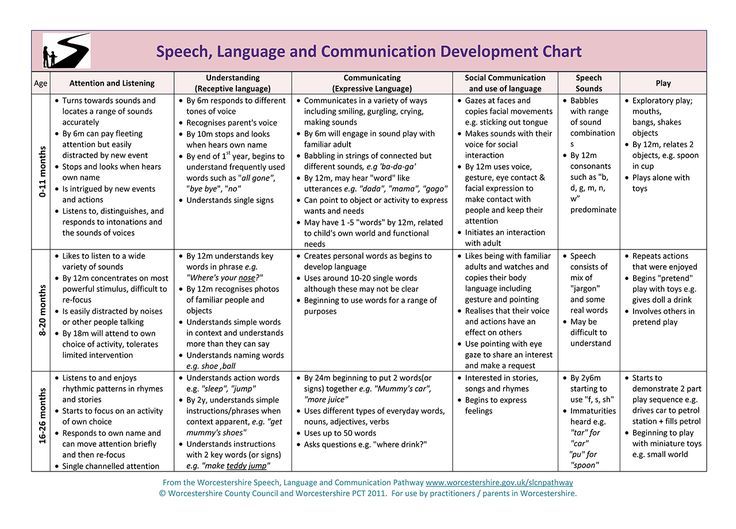
The sounds uttered by the baby should be duplicated, repeating repeatedly. All manipulations related to eating, washing and other procedures need to be spoken out, and more often communicate with the child not out of necessity, but to establish contact. By repeating after the baby the combinations of sounds he utters, adults, as it were, stimulate him to a new imitation. It is important to remember that such activities will not bring results if the child is hungry, cold, tired, etc.
In the second half of the year, for development, it is necessary to consider objects and toys more often, naming them, accompanying the child’s movements with words. To stimulate baby's speech at six months, it is important to evoke the baby's need to speak. For these purposes, you can not immediately give the toy that he asks for, but wait for the speech reaction ("Lala, bi-bi").
You need to ask the child questions, the answer to which is the words “yes” or “no”. It is important to offer onomatopoeia if the baby finds it difficult to name the subject: “What can I give you? Doggy? Av-av?”, “Where is the car? Where is the BBC? Such a strategy of parental behavior will bring significant results in the form of active speech activity.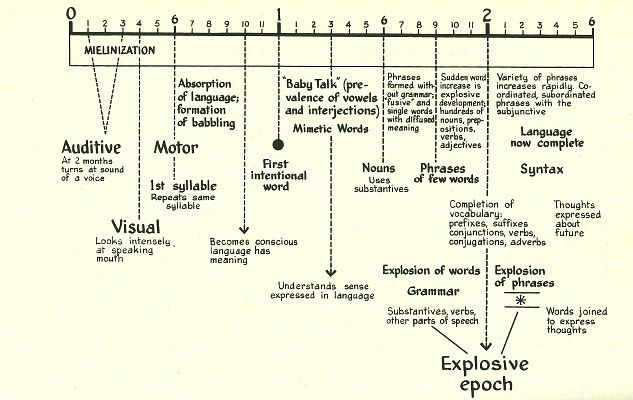
The development of fine motor skills also leads to a leap in the development of speech. If the parents taught the child to wave a pen when saying goodbye, to stretch it out, saying hello, then a one-year-old child will perform these movements, as soon as an adult asks him about it.
Attentive mom and dad stimulate the baby’s movements with the words: “Get up, lie down, sit down, take it, put it down, lift it up.” A little later, as soon as the child learns to walk, they are added to them: “Come, come, stop.” You can teach your baby to refrain from doing the wrong thing or prompting the word “no” with a strict intonation. It is important to remember that this word should not be abused, otherwise the ban simply will not work. Endless "no" will become just background noise and will "fly past the ears."
If the child does something wrong, you need to offer a replacement for his wrong actions, for example: “You can’t hit the kitty on the back, you can stroke it.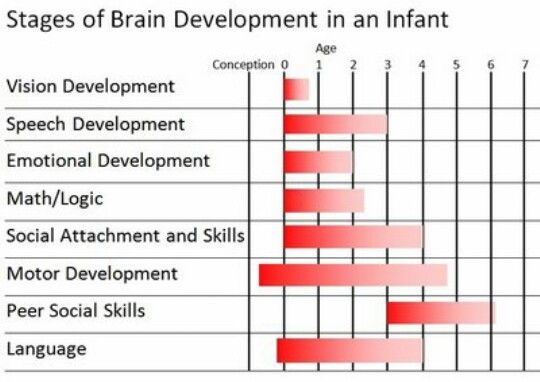 ” And then show how to "stroke". It may not work the first time, but with regular repetition, everything will be learned very firmly. With an active examination of the surrounding world, the word-prohibition will become a kind of boundary of personal space. The big world frightens the baby, and such boundaries are vital for him to feel more confident.
” And then show how to "stroke". It may not work the first time, but with regular repetition, everything will be learned very firmly. With an active examination of the surrounding world, the word-prohibition will become a kind of boundary of personal space. The big world frightens the baby, and such boundaries are vital for him to feel more confident.
Abnormalities
At risk, in terms of impaired speech development, are premature babies with very low birth weight, children with hearing and vision impairments (how to check a child’s hearing), with muscle hypertonicity, with insufficient functioning of the cranial nerves, the presence of structural changes in the brain.
A common cause of delayed speech development is a lack of education, when a child is not taken care of, he does not have enough attention. With pedagogical neglect, parents should immediately take up the elimination of their mistakes.
Symptoms of a deviation in the development of an infant's speech from the norm:
- The child does not hoot and coo in the first year of life, he does not fix his eyes on a moving object;
- No "animation complex", reaction to emotional speech;
- Delay of babbling period by 6 months, no interest in the outside world;
- Cooing and babble monotonous, very quiet, unemotional, without intonation;
- The tongue is incorrectly located in the oral cavity, spasms of the muscles of the mouth and tongue are noticeable;
- By 9–12 months, simple monotonous babbling is retained in speech;
- The child is lost, looking for the source of the sound with his eyes;
- Children with speech development problems associated with damage to the central nervous system have difficulty chewing, swallowing, they cannot drink from a cup, they often choke on food;
- The child is indifferent to the fact that they do not understand him, he speaks in a "gibberish" language, understandable only to him alone;
- By 12 months, children with pathology of speech development do not appear not only ordinary, but also babbling words.
They prefer instead to express their desires with gestures, facial expressions or lowing.
If the speech manifestations of a one-year-old child do not correspond to the age norm, you need to contact a specialist: a pediatric neurologist, an otolaryngologist. The baby's body is plastic, with an early start of correction it is easier to overcome speech development disorders.
An untimely corrected speech delay, detected at an early age, can lead to the intellectual lag of such children from their peers and a delay in psychoverbal development. The delay in the development of speech makes the child withdrawn, irritable, sometimes aggressive. His mental development slows down, subsequently the process of mastering reading and writing becomes more difficult.
It is necessary to control the mastery of speech from an early age. During this period, with the help of simple games with sounds, the articulatory apparatus and hearing of the child are actively exercised, the ground is being prepared for the proper assimilation of the native language.![]()
The main tasks facing parents of children with speech pathologies can be formulated as follows:
- Vocabulary expansion;
- Correction of inaccuracies in spoken words and phrases;
- Teaching the ability to correctly construct statements;
- Attentive attitude to children's issues.
The main thing to remember is to force the baby to speak. The above examples of deviations give parents the opportunity to understand how well the speech development of their baby is going, whether there are any problems that require urgent intervention from specialists.
Recommended reading
Speech development
August 25, 2022
Development of a baby's speech from 1 to 2 years old
A baby's speech is actively replenished with new words and phrases a year, becoming more active by the age of two. But most importantly, it becomes the main means of communication.
Development of speech
August 25, 2022
Why a baby does not speak in a year
Let's see if it is so important to worry if a baby has not uttered a word for a year.
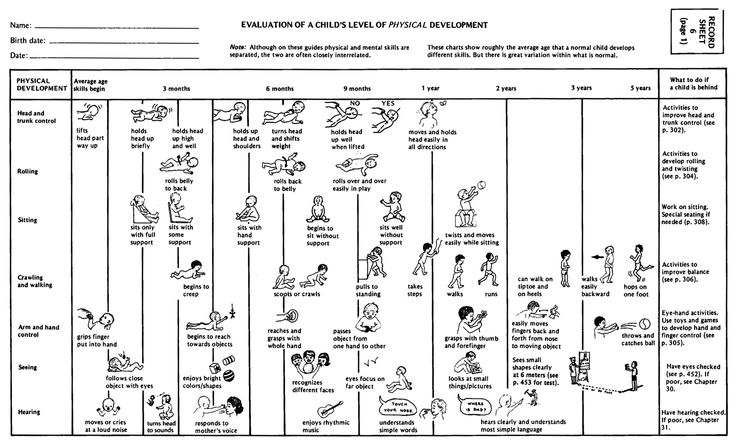 Knows one or more words well enough to use them.
Knows one or more words well enough to use them.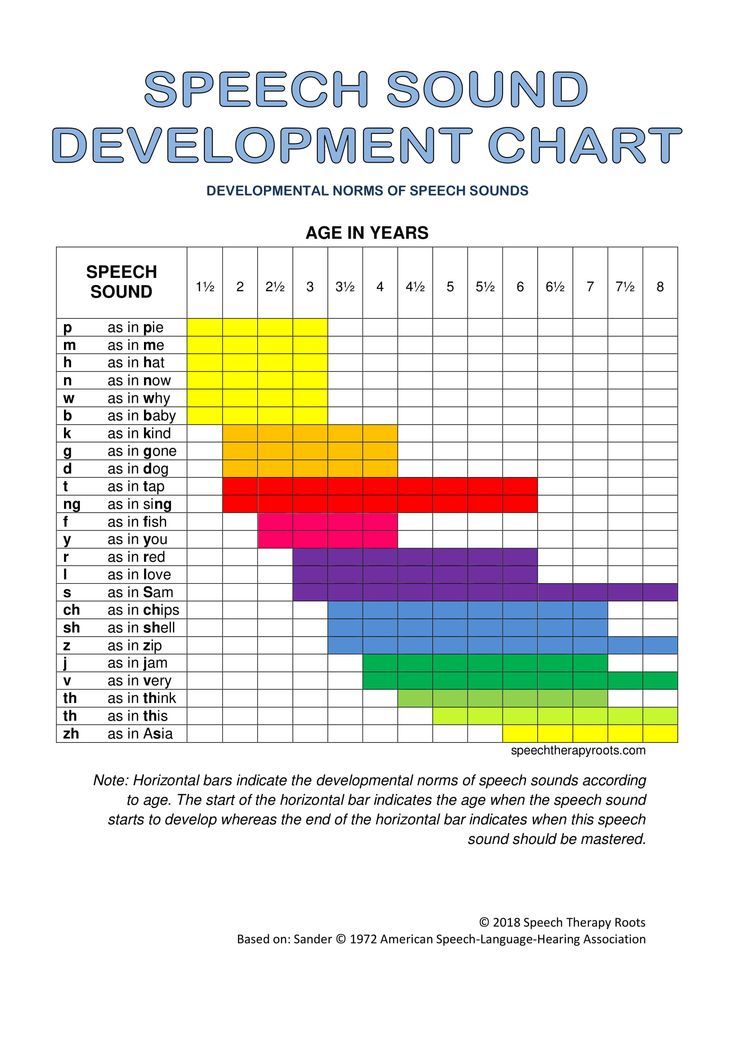
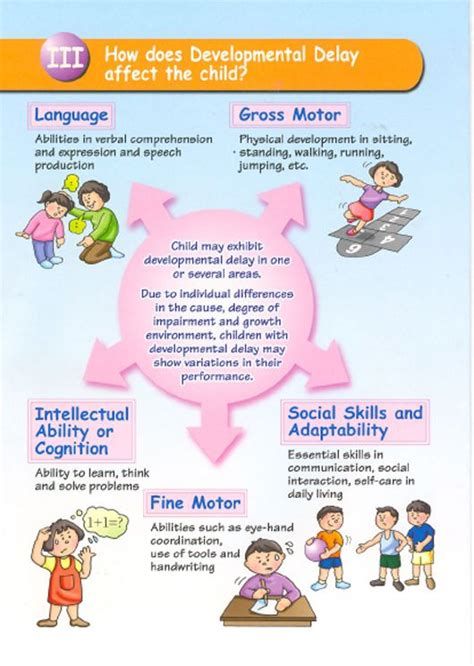 " Can be understood most of the time. Can tell you what happened if you were out of the room.
" Can be understood most of the time. Can tell you what happened if you were out of the room.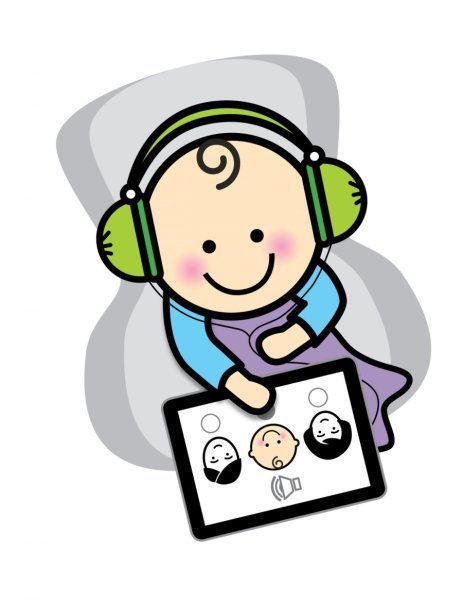 "
"

